64 Elegant Gray Living Room Ideas for a Stylish and Timeless Interior
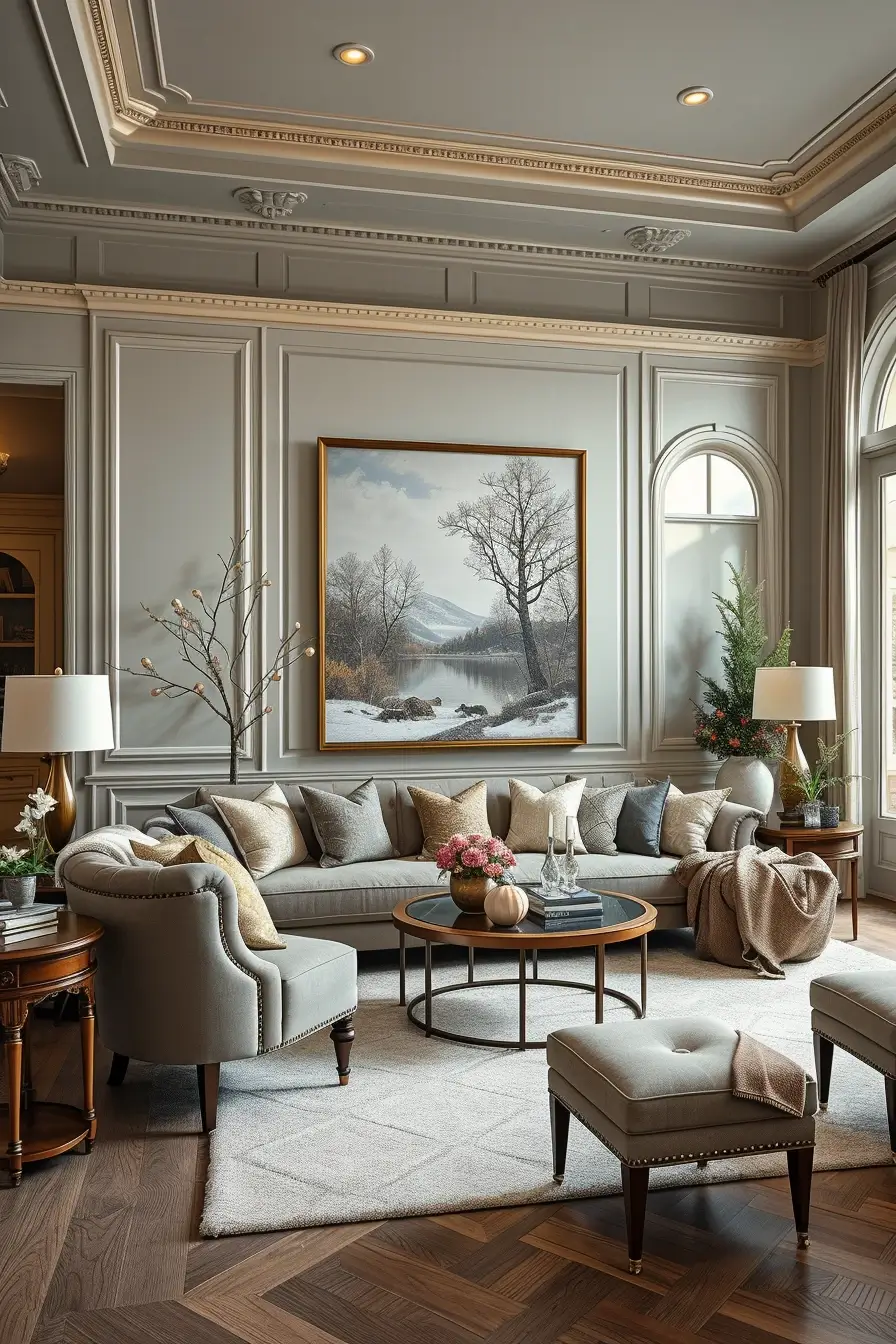
A classy gray living room is a timeless and universal base to any house that is both elegant and cozy. But what are the correct gray shades to use to make your space warm and not cold? And what furniture, textures and accents will actually make the design? In this article, I am going to take you through some of the practical concepts and professional tips that will enable you to come up with a gray living room that is both luxurious and inviting. Your preference may be dark charcoal drama or light dove-gray tranquility, but you will find inspiration here to fit your own style.
Looking into the right gray palette, adding depth with layering of different shades, and adding considerate materials, you can transform a simple idea into a stunningly curated interior. I will tell you how I personally combine warm and cool undertones, choose the pieces that stand out and combine colors and textures to create the most effect. We will work together to make a room that is comfortable to live in every day and is impressive when it comes to entertaining guests.
The Essence Of An Elegant Gray Living Room
To my mind, the key to a beautiful gray living room is that it can be an all-purpose chameleon, as capable of fitting with modern minimalism as it is with soft traditional appeal. My first step is to define the general mood that I would like to create. Pale gray background creates lightness and airiness, and darker colors bring depth and elegance. You should choose a shade that will match with the natural light in your room. Light grays are more likely to brighten the daylight whereas darker colors provide a cozy feel during the evenings.
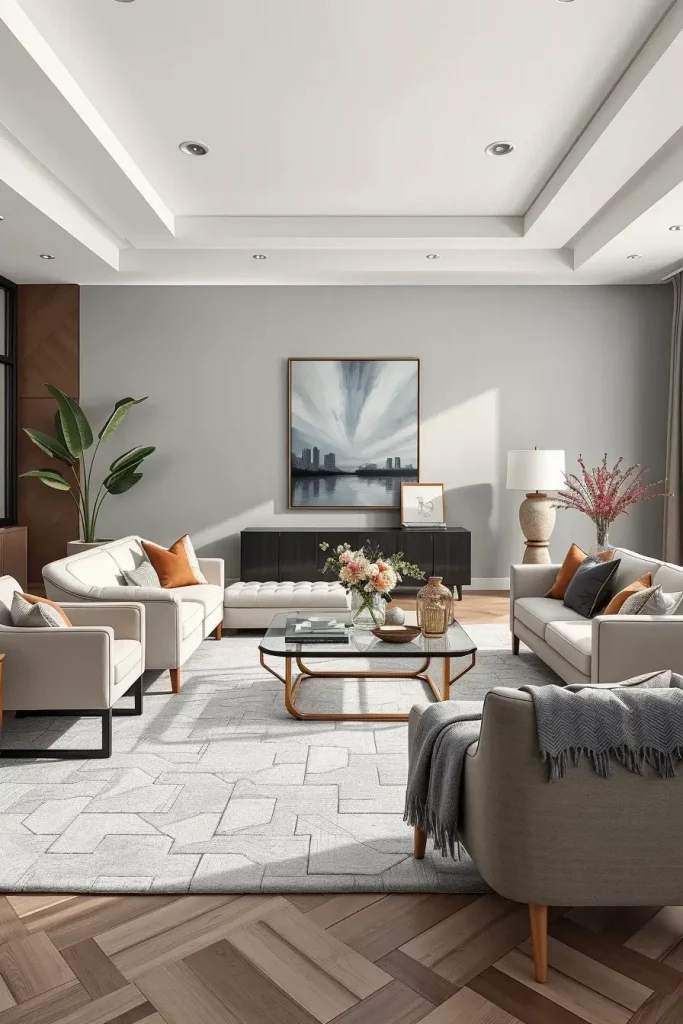
Furniture-wise, I prefer minimalist sofas, modern armchairs, and glass or marble coffee tables to maintain the area classy. I also discover that textural depth is achieved by layering fabrics like wool throws, velvet cushions and silk curtains. A well-placed rug that has a discreet pattern can assist in grounding the sitting arrangement without dominating the scheme.
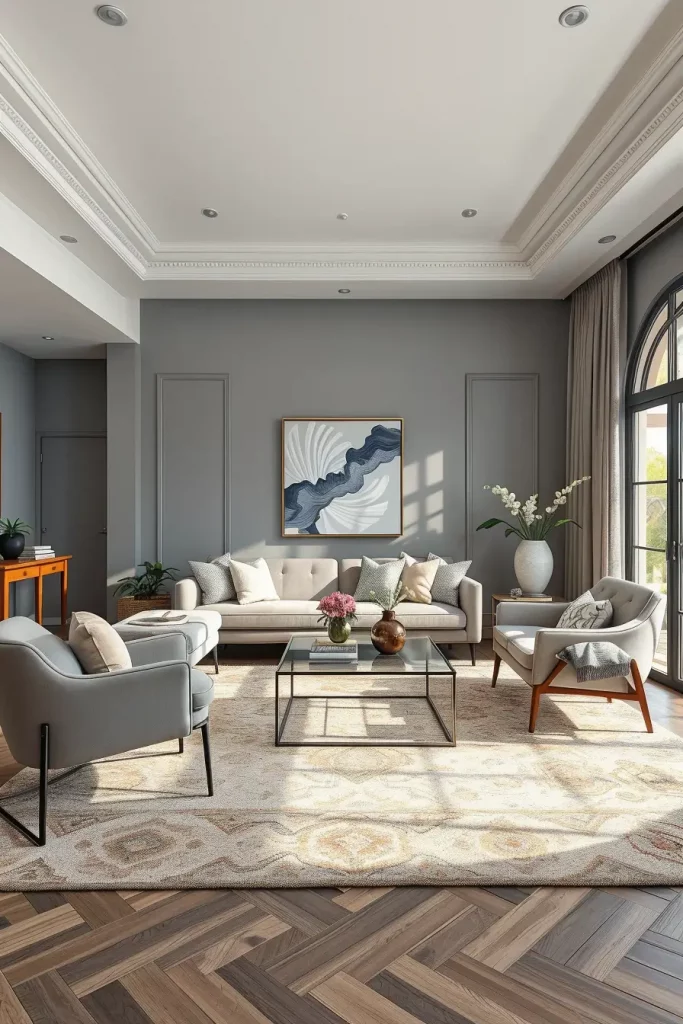
In my experience, it is best to keep it simple, too many colors or fancy details will take away the grace you are trying to achieve. Popular interior designers in the U.S. (e.g. Nate Berkus) tend to stress that the key to sophisticated design is simplicity and cohesion. I do heartily agree.
The only other thing that I would like to add here is more curated artwork. A monochromatic palette can also be used to enhance the room by choosing two or three large-scale, well-framed works that do not create clutter.
Choosing The Perfect Gray Palette For Your Space
Choosing the appropriate gray is not as simple as it seems-undertones count. The first thing I do is to think about whether my room is warmer or cooler natural light. In northern facing rooms, I tend to recommend warm grays with a touch of beige or taupe so as not to feel cold. Cooler grays may be used in sunnier rooms to balance out the brightness and achieve a more relaxing background.
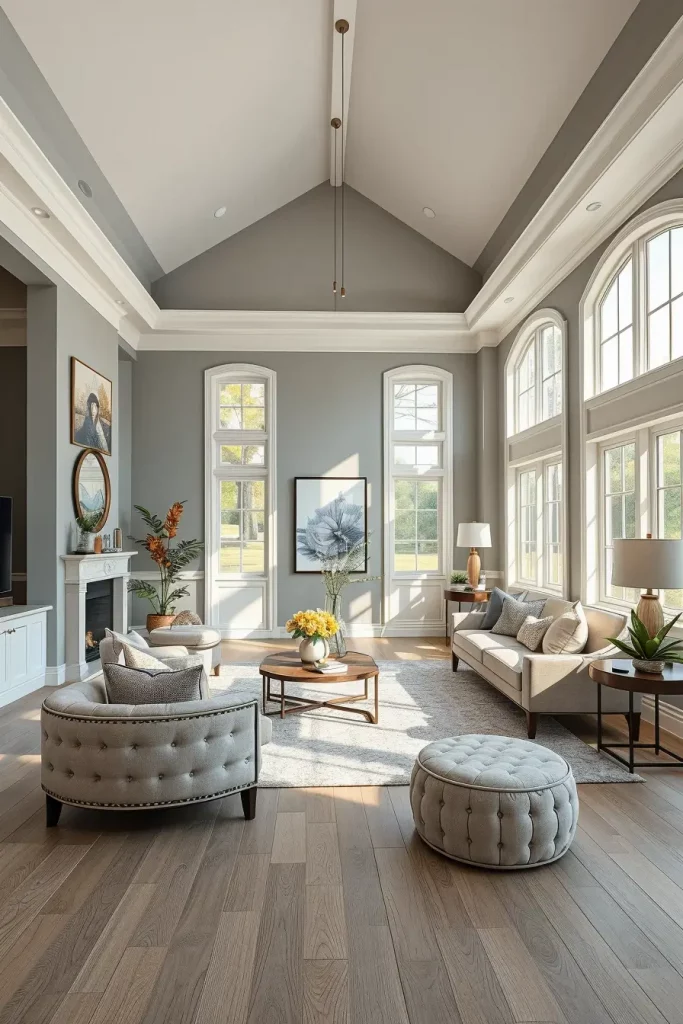
I prefer to put a few swatches on various walls and see them over the course of a day. A gray that seems to be perfect in the morning may seem too dull at night. I use mid-tone grays with crisp white trim in my projects to create a sharper contrast or creamy off-whites to create a softer transition.
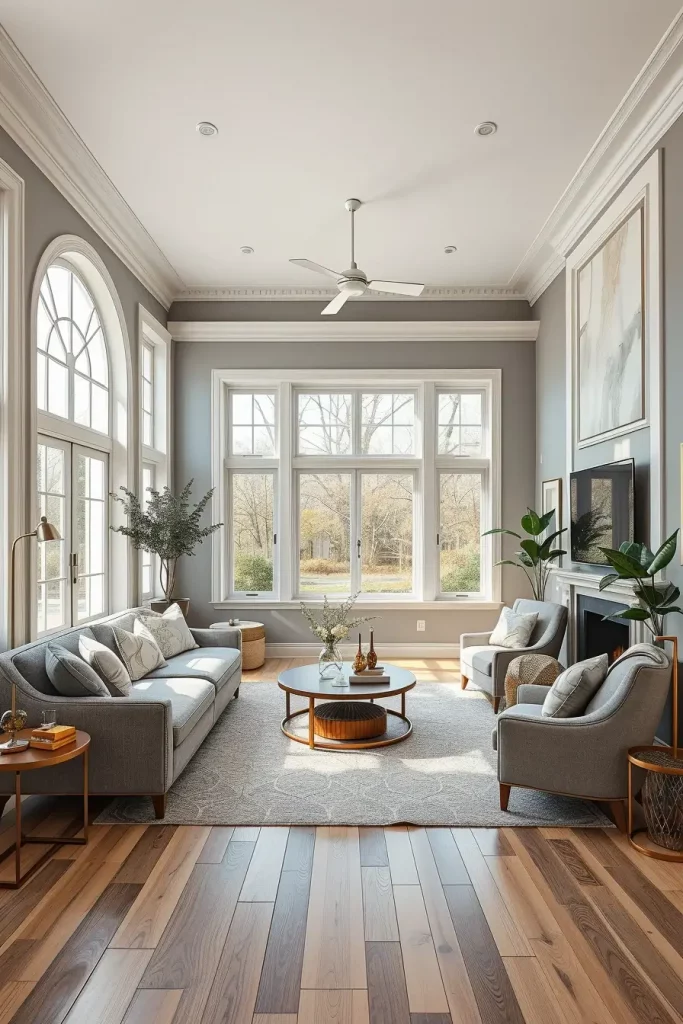
I think it is worth spending money on good paint-it will cover better and have more color. I take the recommendations of the design team at Benjamin Moore, who suggest that when it comes to grays, at least three shades should be sampled before a decision is made.
The thing that people usually lack when approaching the flooring is the color of the floor. A gray with complementary undertones will look good on floors that are warm-toned wood; a neutral or blue-gray will look better on cool stone or tile.
Balancing Warm And Cool Gray Tones
Everything is balance in my design process. An excessive amount of cool grays can make a room sterile, and an excess of warm grays may be too soft. They are best combined with a considered touch, say a warm-gray sofa and cooler-gray walls, or the reverse.
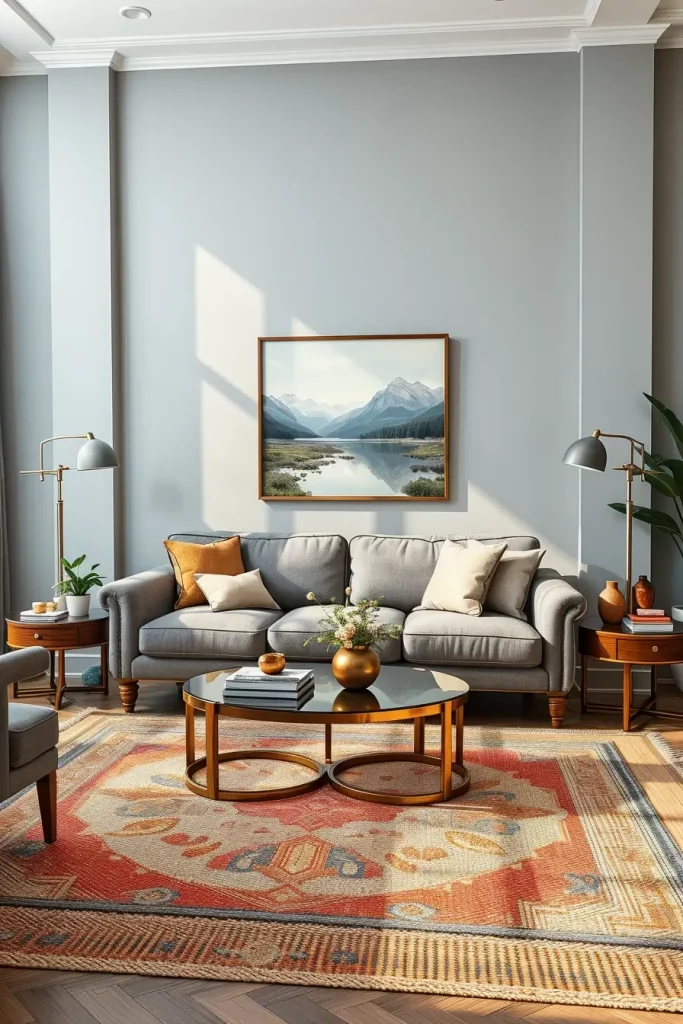
The gap can be filled with furniture choices. As an example, I will frequently contrast a cool-gray sectional with warm wood side tables, or a warm-gray armchair with polished chrome lighting. These minor differences make the space interesting to look at without conflicting.
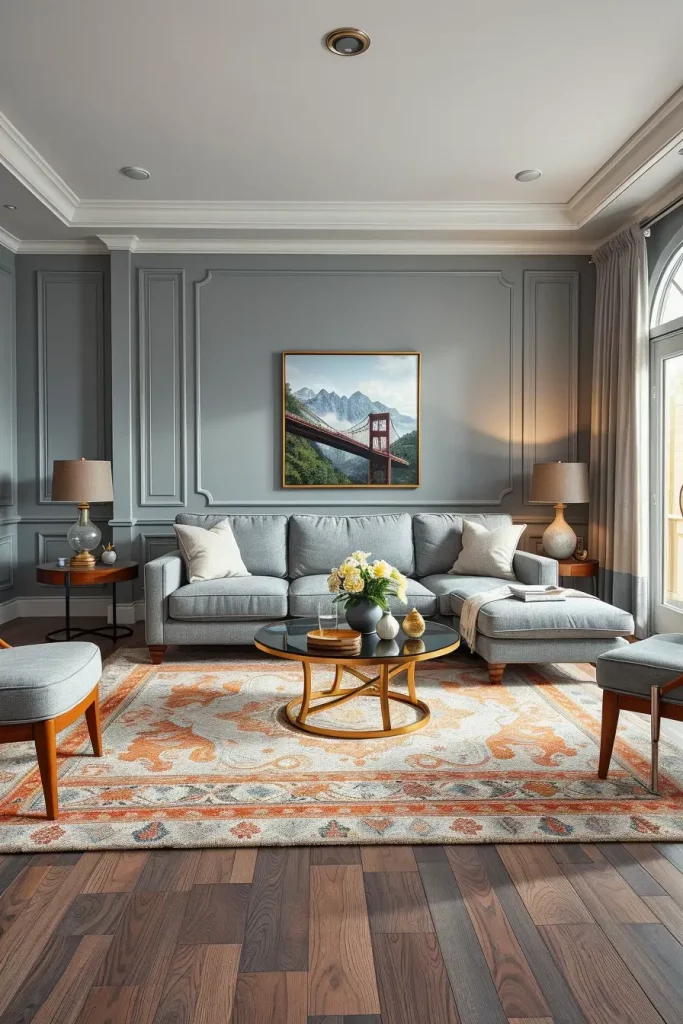
Through practice, I have observed that customers are sensitive to a layering temperature strategy. This interaction brings in complexity and sophistication as Architectural Digest frequently recommends. One temperature all the way can be dull; a combination of hot and cold feels curated.
I would also suggest adding a neutral colored area rug that incorporates both warm and cool strands of the rug- it is a minor detail but one that pulls the palette together perfectly.
Creating Depth With Layered Gray Shades
Layering several shades of gray to provide the room with depth is one of my favorite techniques. I could begin with pale gray walls, add in a middle tone gray sofa and complete with deep charcoal cushions or frames. This flow attracts the attention and gives the design some motion.
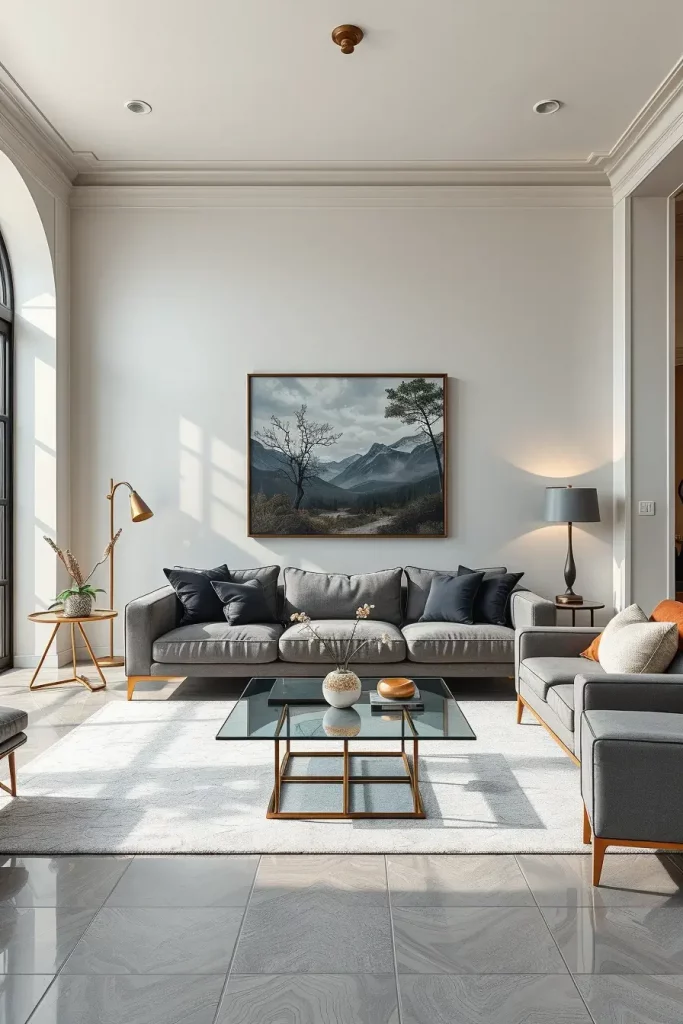
I use simple shapes in furniture choice so that the focus is on the tonal variation. I think glass or metal coffee tables are good here because they do not compete with each other and make the grays shine.
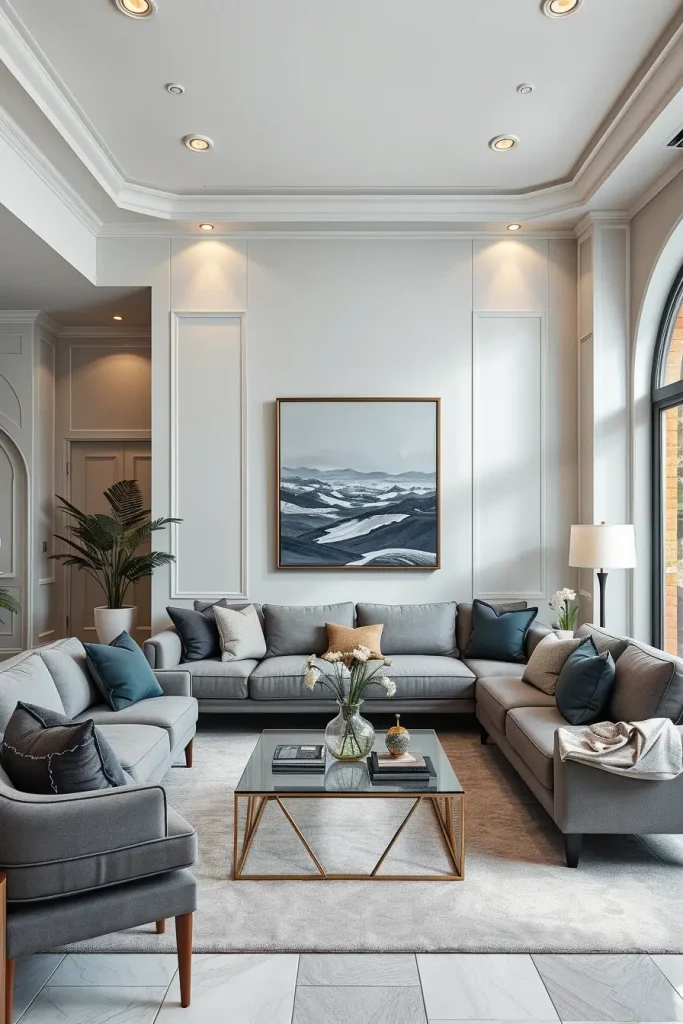
I think that this is one of the best methods to make a high-end appearance without using bright colors. Elle Decor has observed that when layered neutrals are done properly, they can be as impressive as bright schemes.
What I would include here is a combination of matte and glossy surfaces, say a matte wall with glossy ceramic vases, to add the layered effect without being too much to the eye.
Gray Walls As A Timeless Backdrop
I view gray walls as the ideal neutral backdrop when designing, they are timeless, versatile and infinitely adaptable. They permit the art, furniture and accessories to be the focus and still have a unified feel.
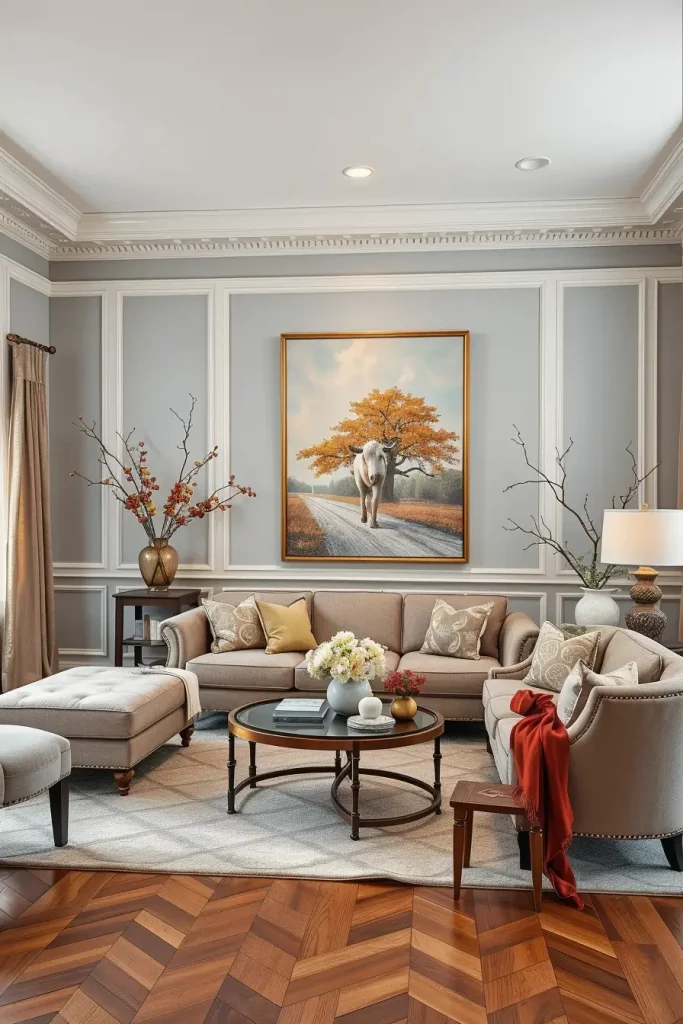
I tend to use mid-tone grays on walls as they are adaptable to either light or dark furniture. Satin finish is simply gorgeous in living rooms, as it has the right amount of shine that reflects light but is not glossy.
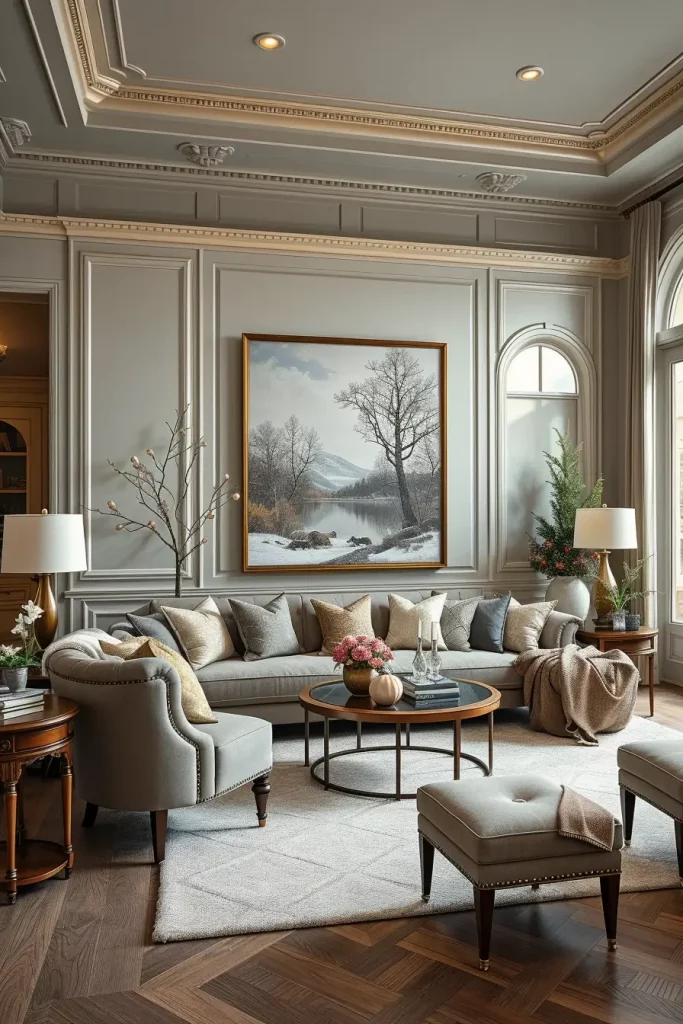
I have always liked how gray walls fit in the seasonal changes of the decor. They go with jewel tones in winter, and pastels in summer. The ability of gray to change the atmosphere has been mentioned by a well-known designer Kelly Wearstler many times, and I must say, she is right.
To finish this off I would incorporate crown molding in a lighter gray or white color- this would provide a little architectural detail without breaking the sophistication.
Incorporating Gray Accent Walls For Impact
One of my favorite tricks to add depth and interest but not overwhelm the room is a gray accent wall. It gives a powerful focal point whether it is a deep charcoal behind the sofa or a smoky slate behind a media unit.
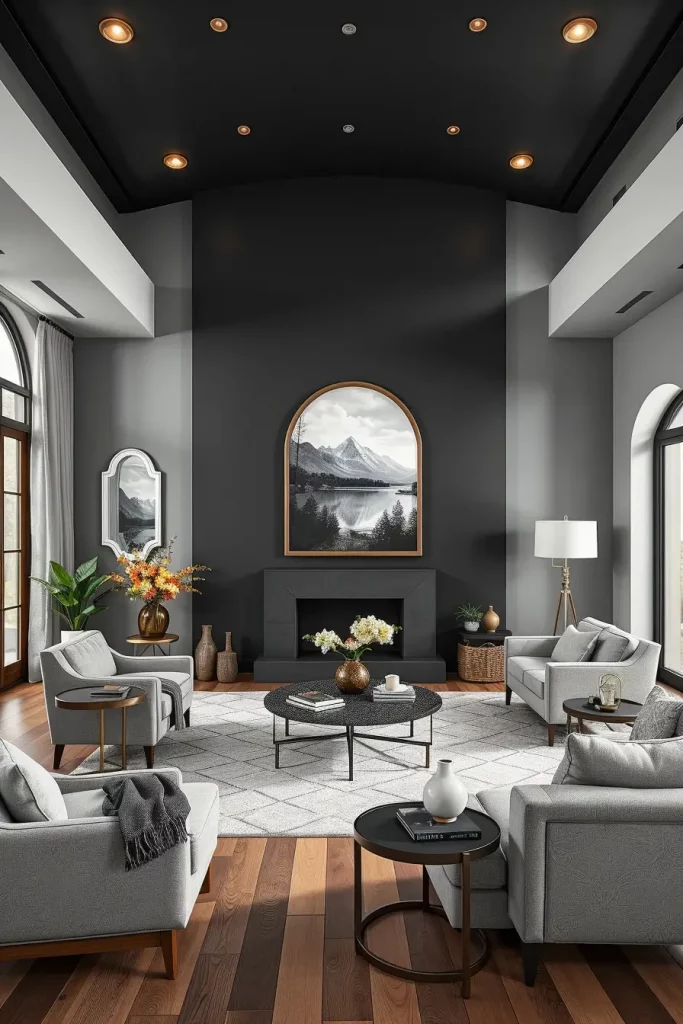
I tend to counteract this with lighter grays on the other walls, so that there is a visual hierarchy that attracts the eye where I want it to. The accent wall can be combined with a large-scale art or a statement mirror to make it serve as a design element.
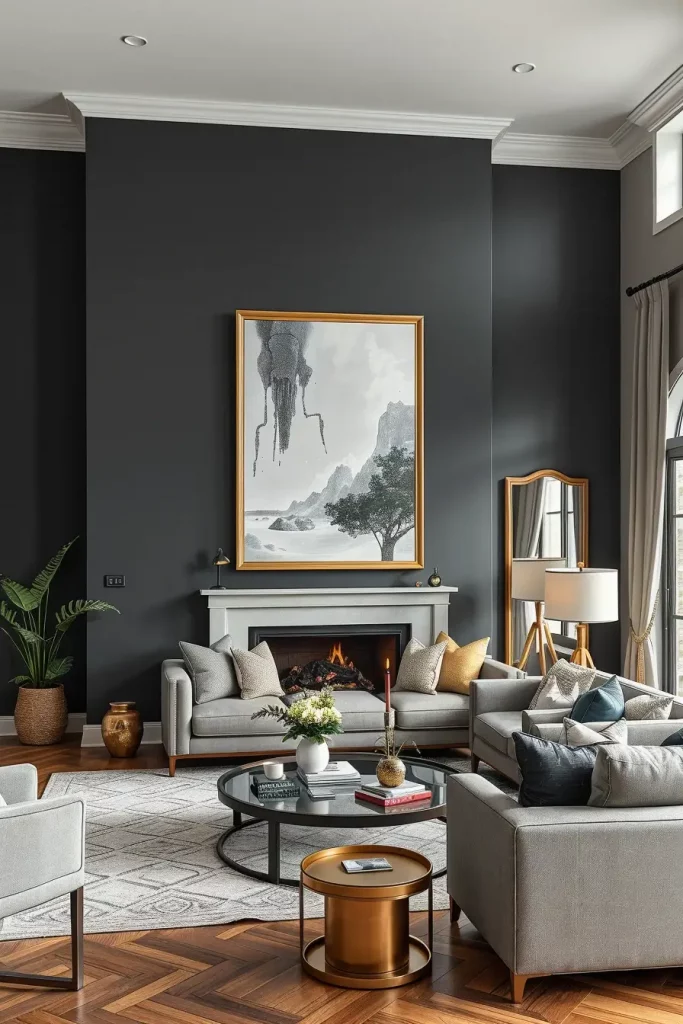
I have personally experienced this method to be very useful in open-plan areas, where it can be used to create zones without the use of physical boundaries. This is a common suggestion of HGTV design experts to achieve intimacy in a big living room.
To take this a step further, I would consider textured finishes, such as grasscloth wallpaper or Venetian plaster in gray, to be a bit more rich.
Using Gray Furniture For A Refined Look
The living room is made elegant and versatile by gray furniture. I prefer to use it in large furniture such as sofas, sectionals, or armchairs, as it will age well and can be modified to accommodate the changes in style in the future.
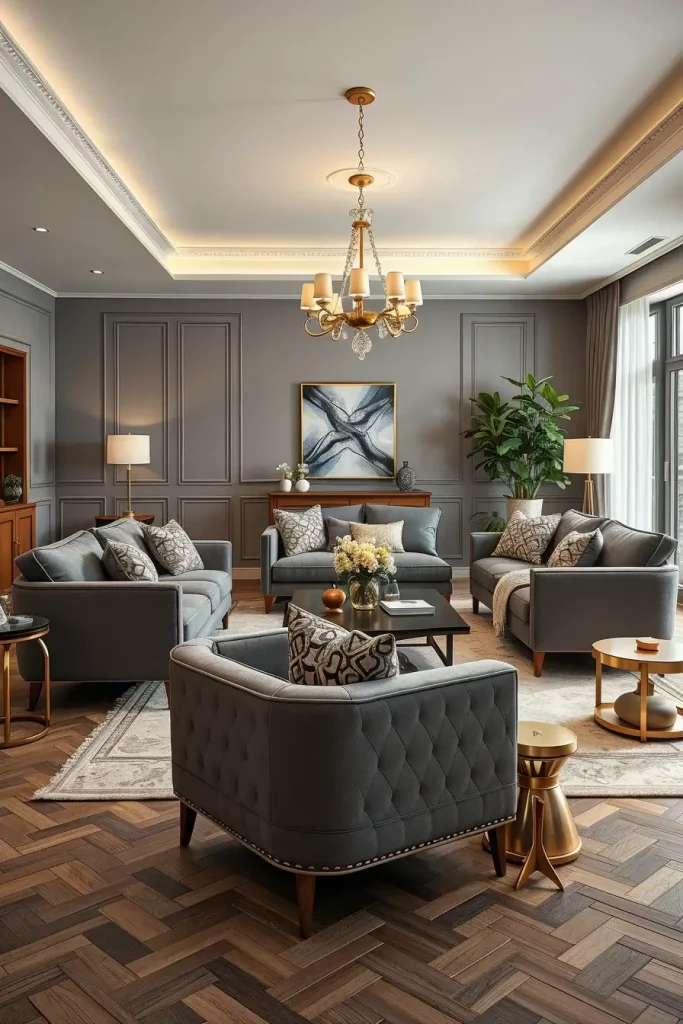
I do not only consider the color of the fabric when choosing gray furniture but also the texture. A slate gray velvet sofa is glamorous, a soft gray linen armchair is casual and sophisticated. Gray furniture is beautiful because it goes well with almost any accent color: blush, navy, mustard or even emerald green.
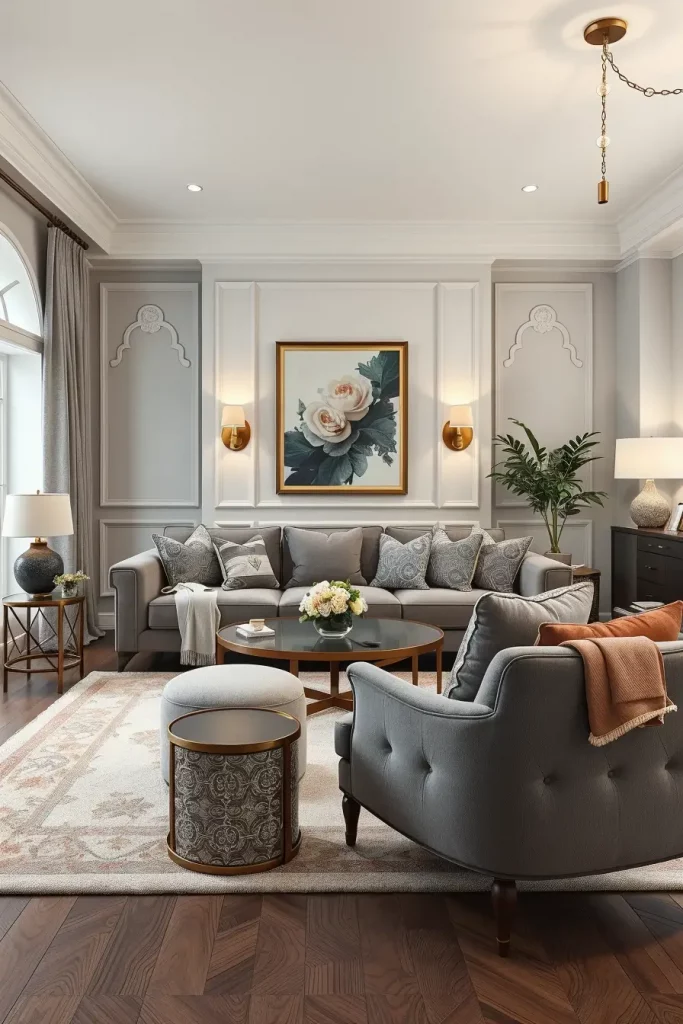
I think that one of the best investments you can make in a living space is to buy a good gray sofa. House Beautiful often mentions that neutral-colored furniture can serve as a design anchor and you are free to update the room with smaller accessories.
What can be even better is to add a patterned throw or cushions with some hints of gray in order to give depth but not to take away the overall elegance.
Elegant Gray Sofas As A Statement Piece
In my experience, a beautiful gray sofa can be the focal point of a living room, with a visual and functional comfort. The space can be anchored by a deep charcoal sectional and an airy focal point can be made by a light dove-gray couch. I prefer to use high-quality upholstery, which will not lose its elegant appearance after everyday use.
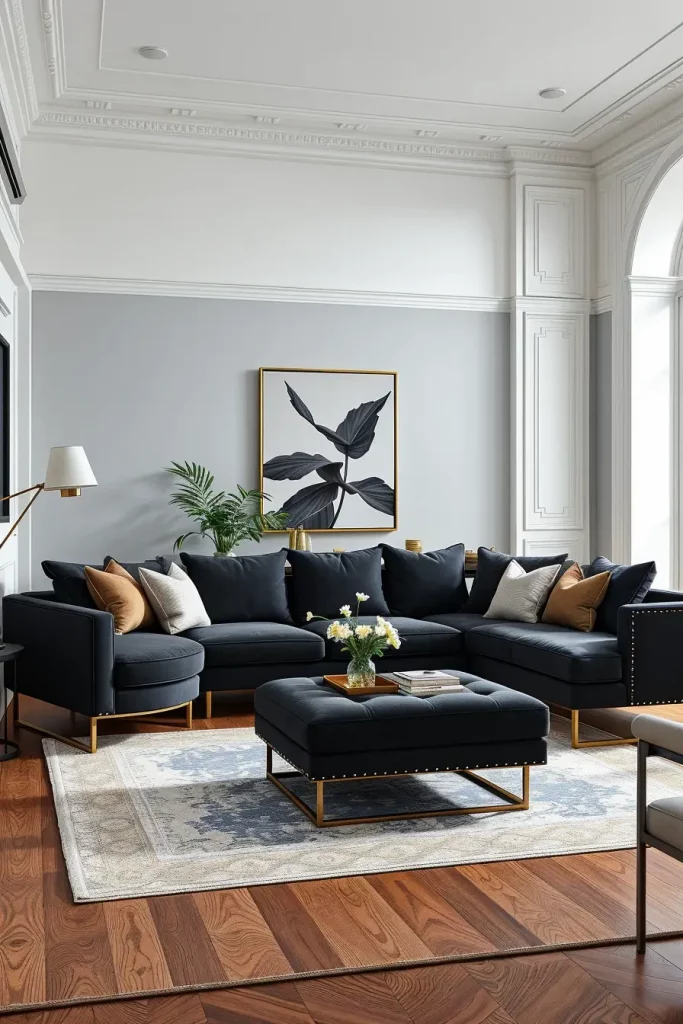
It is the details that count, narrow legs in brass or blackened steel can give a contemporary elegance, tufted backs or sleek streamlined shapes can establish the tone of the room. The combination of the sofa with matching cushions in a dull color or minor patterns will not overpower the design.
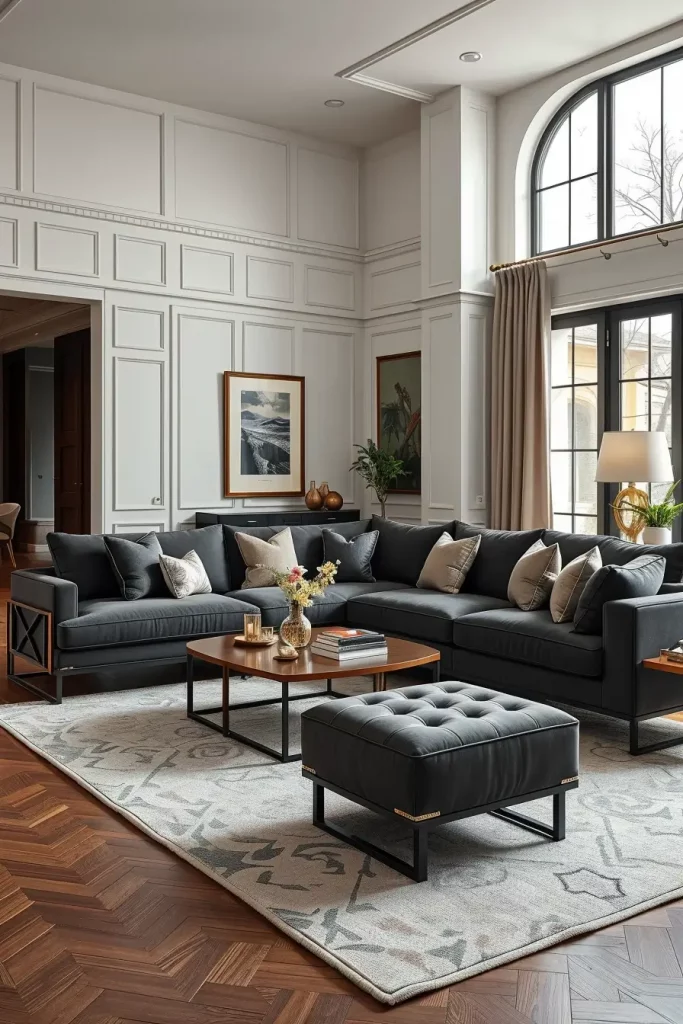
I have observed how a properly selected gray sofa can fit into the changing times. Better Homes & Gardens recommends buying a classic form in a heavy fabric so that you can update the appearance with new throws and pillows seasonally. I do this with my own clients and have never regretted.
The only thing I would add to this would be a matching or coordinating ottoman- both to match the aesthetic and to provide extra seating.
Pairing Gray With White For Fresh Sophistication
The gray and white combination has a clean classic look that suits virtually any living room. I usually suggest soft gray walls with bright white trim to make the architectural elements stand out and to make the room look polished. White is also a visual relief, so that darker grays do not feel heavy.
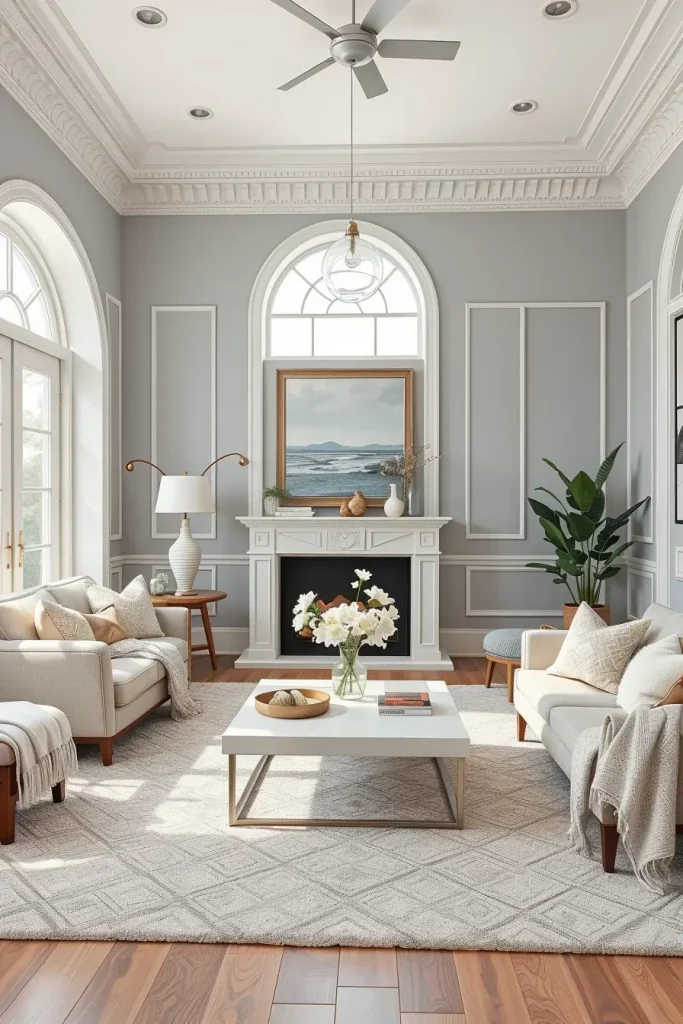
The most important thing is furniture selection- white coffee tables, shelving units, or accent chairs look stunning on a gray background. Throwing in some textured white throws or ivory-colored carpets balances out the contrast and maintains the room welcoming.
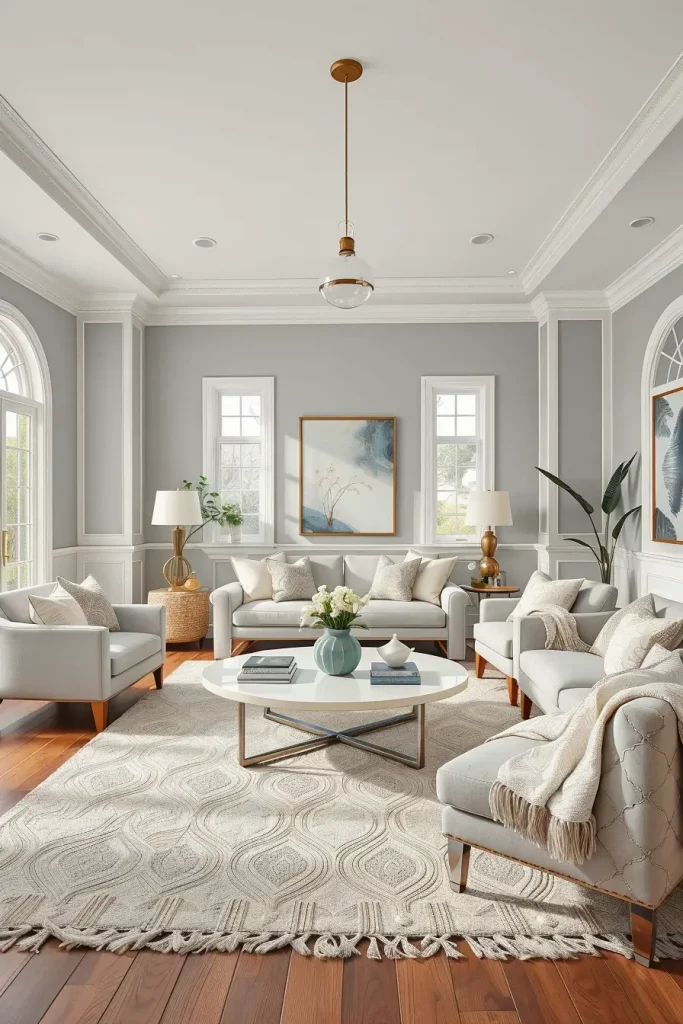
In my opinion, this combination is never outdated. This combination is a favorite of the U.S. interior designer Shea McGee who tends to utilize it to achieve a clean but comfortable appearance, and I have also found it to be very useful in my projects.
What is usually lacking is a little bit of texture contrast, such as a smooth white lacquer side table with a chunky knit throw, so that the scheme does not look flat.
Blending Gray And Black For Modern Drama
I combine gray and black when I want to introduce a striking, modern element to obtain a contrasting effect. The moody and dramatic effect can be achieved by a charcoal wall behind a slate-gray sofa and not overpowering the room.
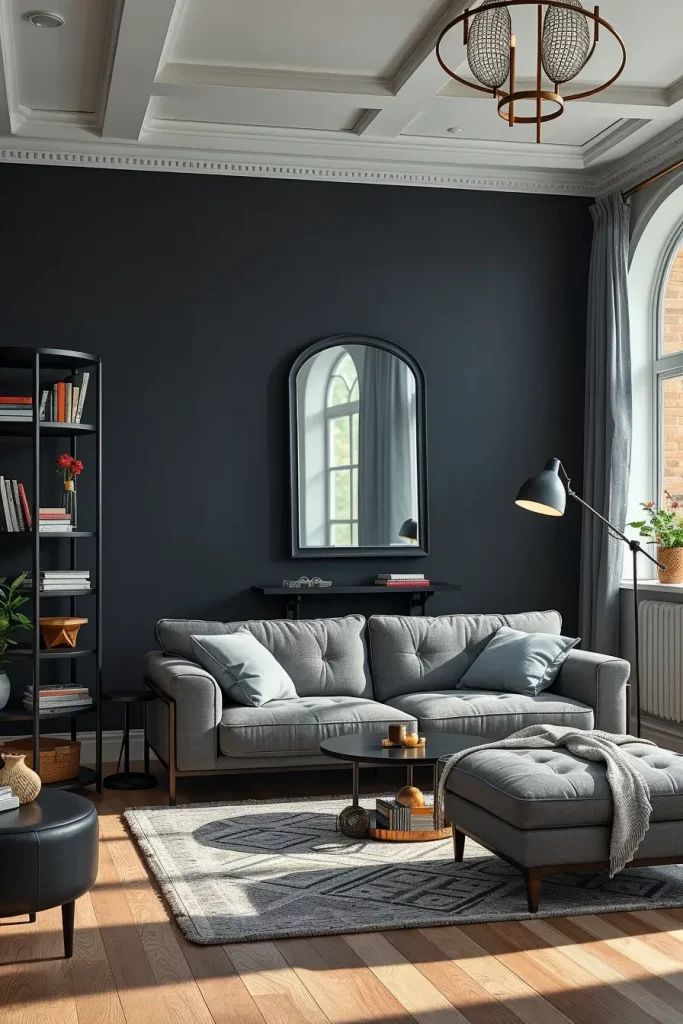
I use black in the form of lighting fixtures, coffee tables, and picture frames. To provide structure to the design, a matte black floor lamp or metal-framed bookshelf can be used, but maintain the palette.
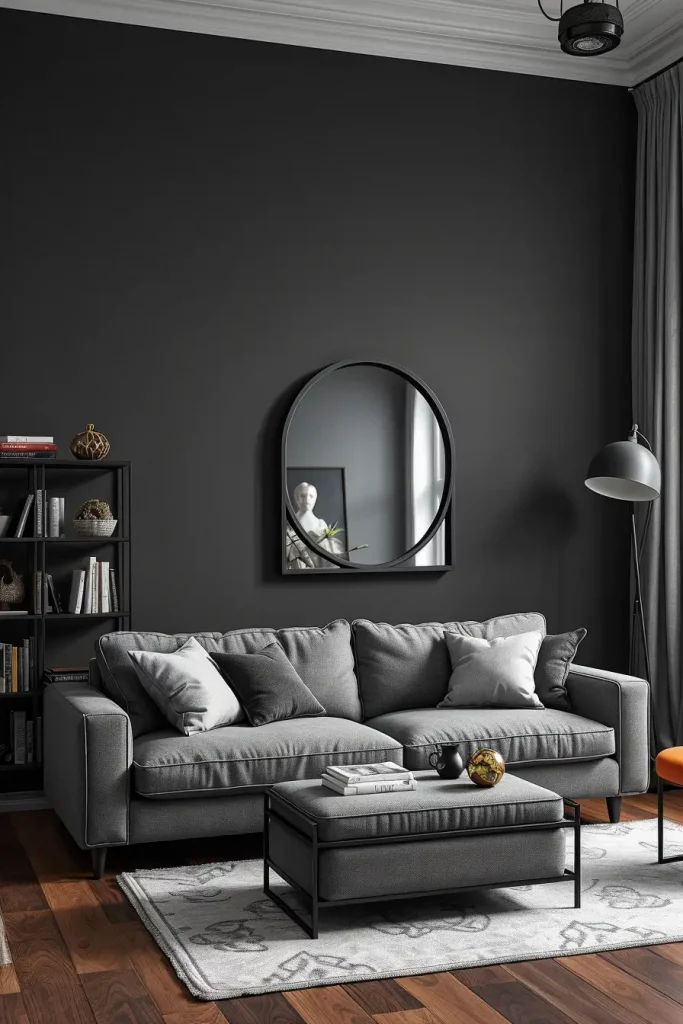
In my personal experience, I have found that the trick to success in this is balance, the black elements are to be used sparingly enough to accentuate, but not overpower the gray tones. This combination is ideal, as Elle Decor says, when homeowners seek a high-impact and sophisticated appearance.
To make this even better, I would include a mirror with a black metal frame to reflect light and make the overall intensity of the color scheme softer.
Accentuating Gray With Metallic Finishes
Metallic accents pair well with an elegant gray living room, and they create a touch of glamour without overshadowing the relaxing base. I prefer to combine brushed gold or warm brass with warmer grays, and cooler grays look fabulous with chrome or silver finishes.
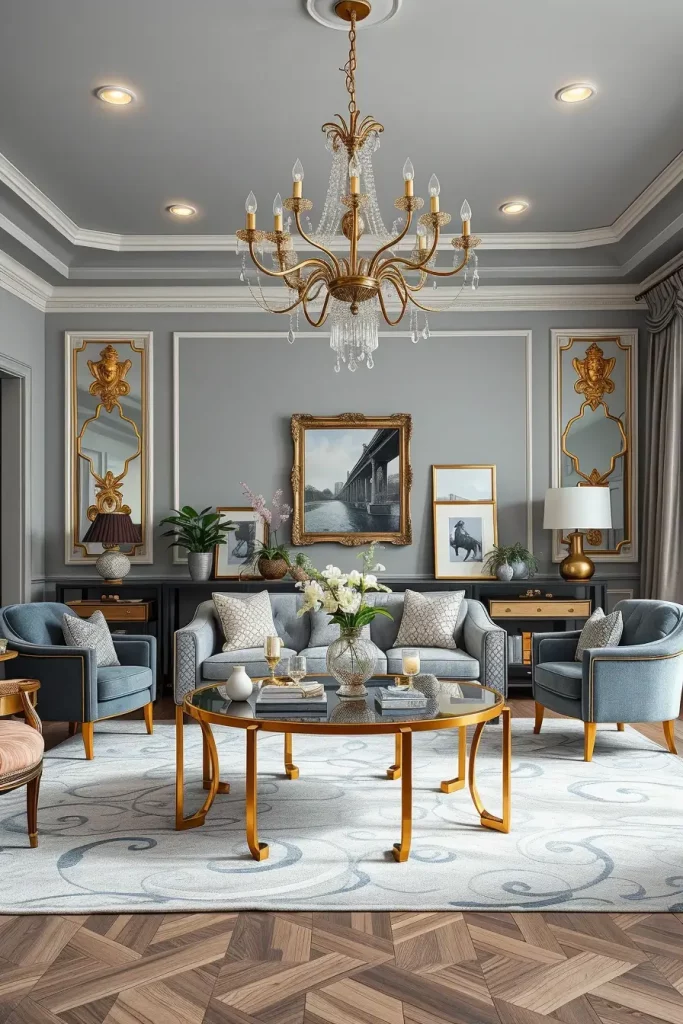
I tend to use metallics in coffee table legs, light fixtures, decorative trays, or even picture frames. These details are glamorous and eye-catching but they do not require much focus.
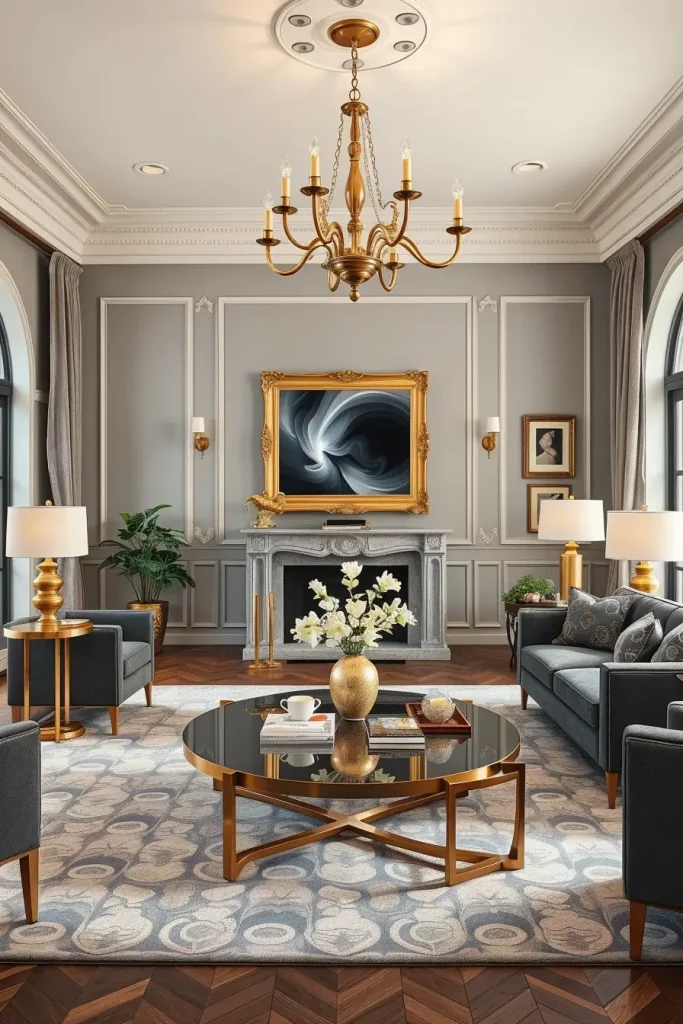
Personally, in my own projects, I have discovered that metallic finishes also aid in the spreading of light in the room, making the room brighter. House Beautiful has frequently called attention to this as a simple but effective method of improving a neutral interior.
Taking this idea one step further, I would add a statement chandelier with mixed-metal accents- it is a statement piece that pulls the room together.
Softening Gray Interiors With Plush Textures
To avoid a gray interior being too severe, I add plush materials such as velvet cushions, faux fur throws and heavy woven rugs. This haptic diversity makes the area friendlier and aesthetically appealing.
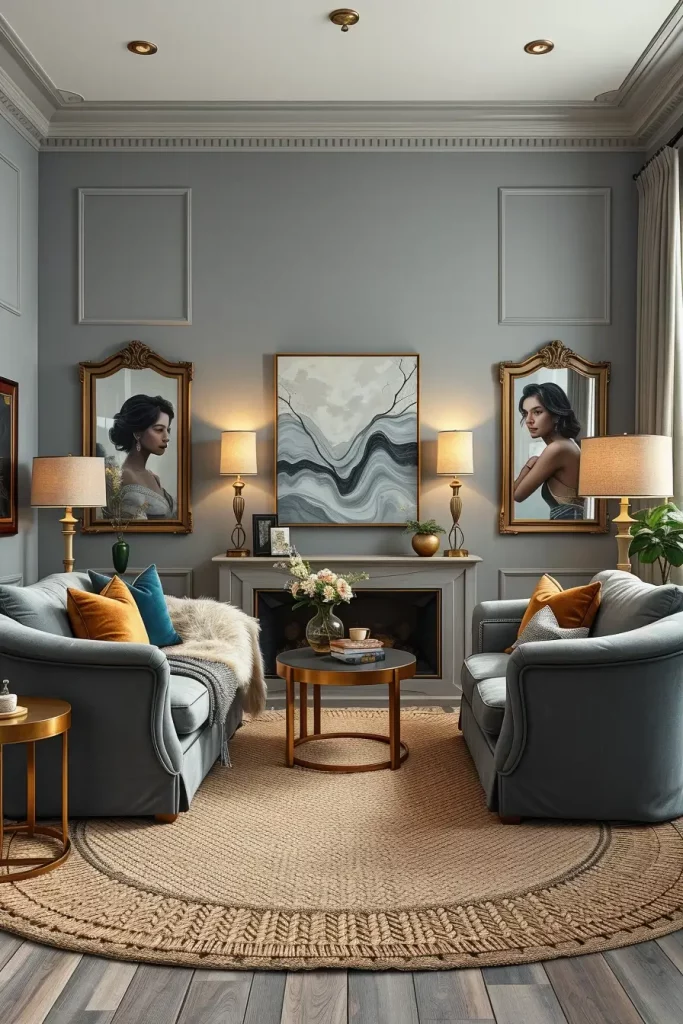
The furniture selection in this case must be comfortable but not losing the elegance, i.e. a deep-seated, soft sofa, large armchairs, and a layered rug arrangement. I have also employed floor-to-ceiling curtains in luxurious materials to provide the room with a warm and acoustically soft feeling.
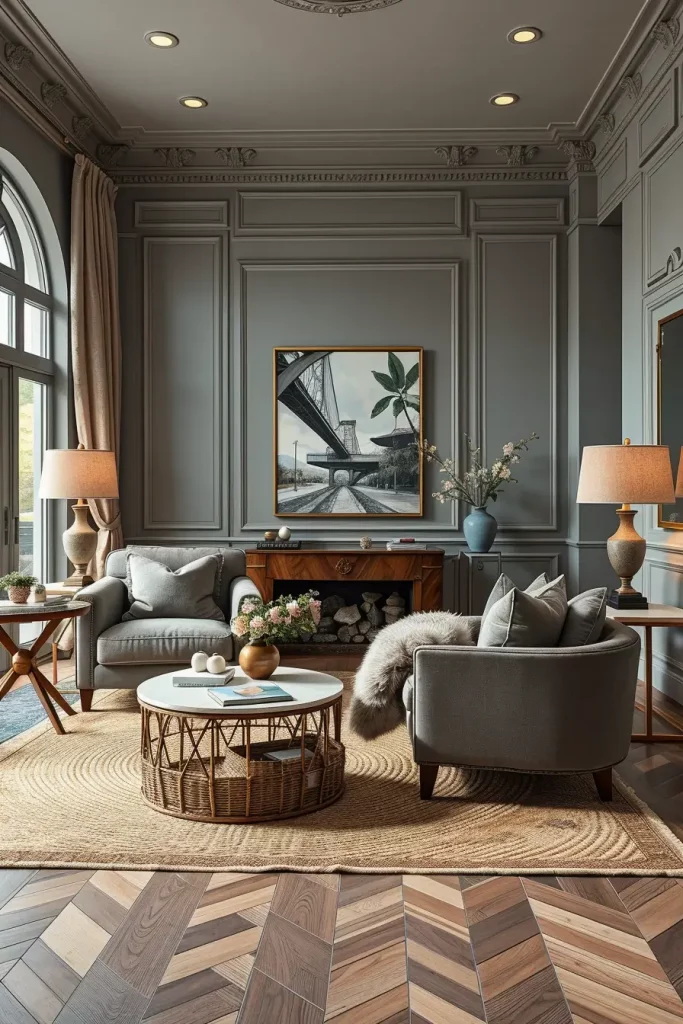
I think texture is as important as color in setting atmosphere. Architectural Digest designers frequently emphasize that a neutral room can be complete only with the help of tactile diversity, and I completely support their idea.
What these arrangements usually lack is layering of light- you can add table lamps with fabric shades to add to the softness of the textiles.
Introducing Natural Wood For Warmth
A chic gray living room is balanced and warmed by natural wood elements. I would like light oak to give a fresh, Scandinavian inspired look or walnut to give a darker contrast. Wood is a beautiful medium in coffee tables, sideboards, shelving and even picture frames.
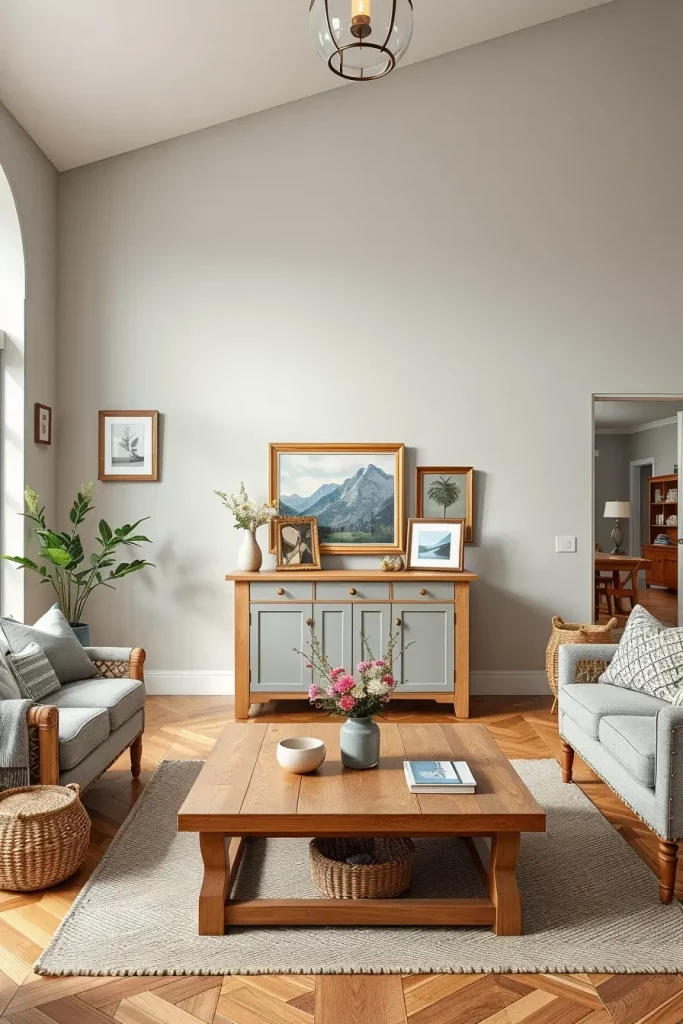
I use wood with gray, but I keep the tones in balance warm grays with warm woods, cool grays with cooler toned woods. This gives a unified appearance free of conflicting undertones.

Personally, I have observed the way wood can make a gray scheme look sterile to inviting. Apartment Therapy has frequently mentioned that wood and gray is a classic combination and I have found it to be just as successful in both contemporary and traditional rooms.
To add some additional warmth, I would include woven baskets or a wooden tray on the coffee table to reiterate the material in smaller elements.
Elevating Gray With Luxurious Fabrics
I tend to lighten a gray living room with fabrics such as silk, velvet or high-thread-count cotton. These materials add depth and slight gloss that reflects the light in a wonderful way.
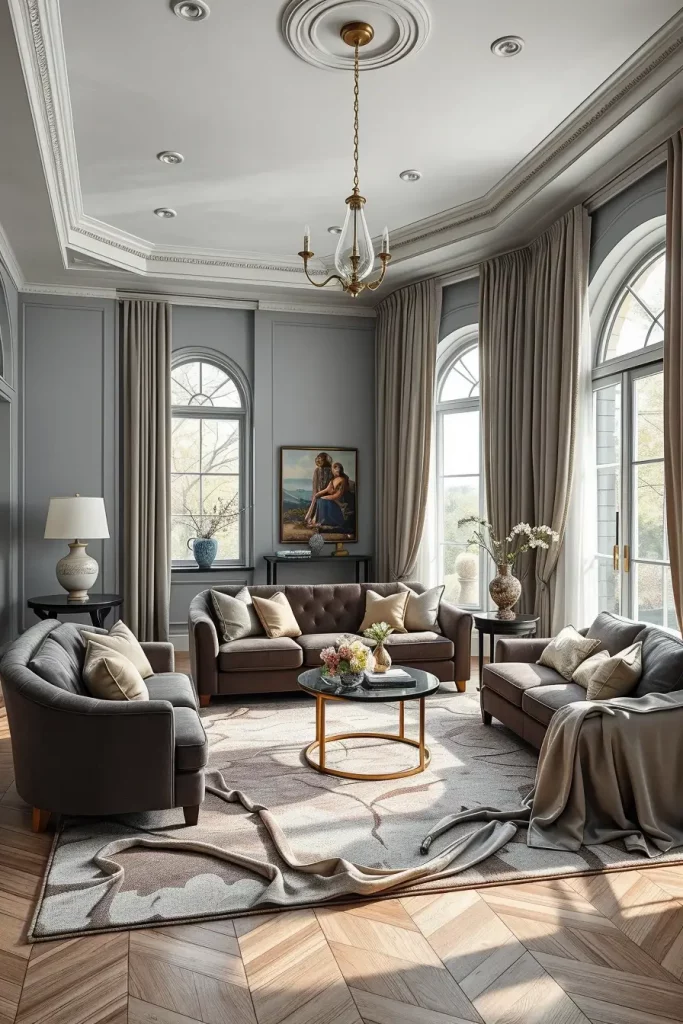
I prefer to put luxurious materials on statement items velvet sofas, silk cushions, or a silky fall of a drape. These immediately give the place a classier feel without the need to redesign the place altogether.
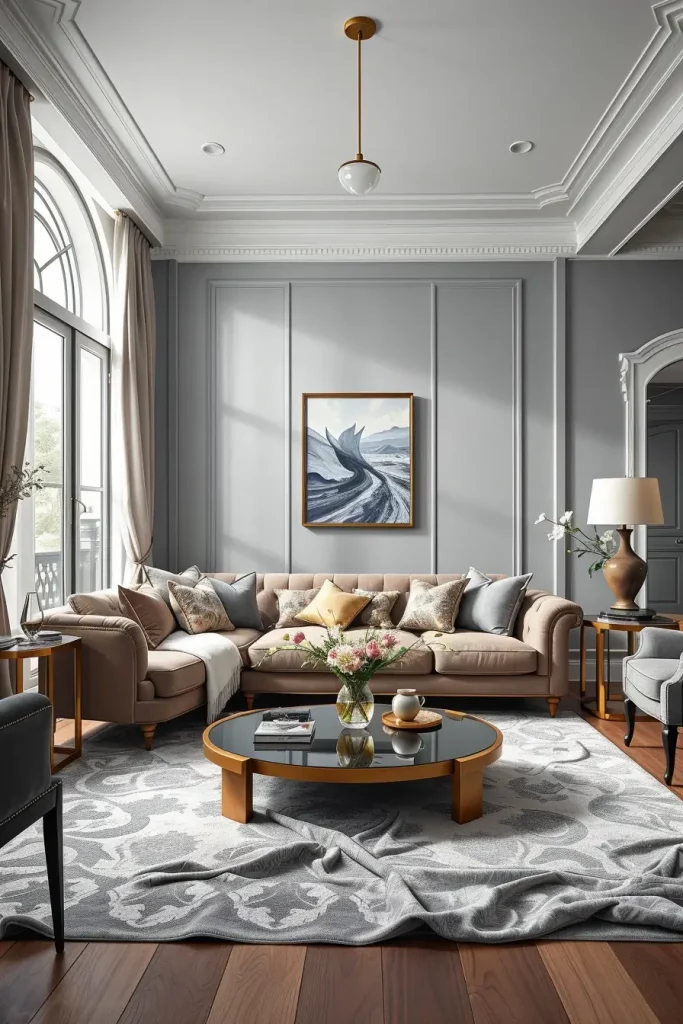
In my personal practice, I have observed that combining various luxury materials within the same palette makes it dimensional. Interior designers in Veranda tend to focus on the fact that tactile luxury can turn a monochromatic room into a multi-layered and dynamic one.
Should I take this a step further, I would add a silk-blend area rug that is light gray to give it a subtle but luxurious feel.
Enhancing Gray Spaces With Artistic Details
When it comes to designing a beautiful gray living room, I usually begin with artistic details since they immediately create the atmosphere of the room. Gray walls are far from bland with the help of artwork, sculptures and decorative wall panels that add texture and depth to the walls. With a neutral palette, well-selected art becomes the center of attention, which will help to ground the personality of the room. I have discovered that large framed art or even faint wall murals are perfect when used against gray tones as they add layers of depth without being too much.

In the case of furniture, I prefer a smooth gray sectional with a low-profile glass or light-wood coffee table. Ornamental pieces, e.g. ceramic vase or abstract sculpture, must reflect the color scheme of the room to create continuity. Putting them on open shelving or a console table helps the room to feel curated as opposed to cluttered.

Personally, I think Elle Decor is right in suggesting that a single statement art should be used to bring out a dull room, and I do concur with this. I have witnessed the power of a room being changed with the replacement of generic prints with a custom or large-scale piece of art. The trick is to select a piece that will work with the undertone of your gray, which is either warm or cool.
A detail I would include here is multiple lighting around the painting- picture lights, sconces or spotlights can make the display seem like it is in a gallery, adding to the effect.
Statement Lighting To Complement Gray Interiors
One of the most powerful means of making an elegant gray living room come to life is lighting. Statement fixtures, like chandeliers, sculptural floor lamps, or extra-large pendants, can immediately give personality to a neutral space. I tend to advise warm lighting to offset the coolness of gray and produce a friendly atmosphere. The juxtaposition of smooth gray walls and a striking lighting object attracts the attention to the upper part and gives the impression of careful planning.
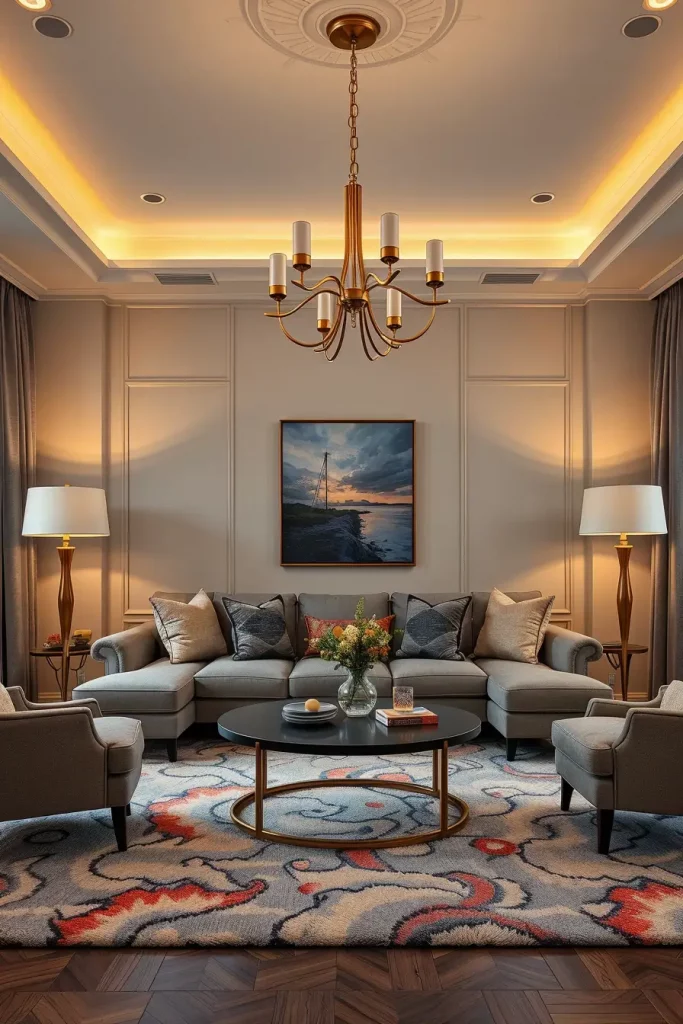
I like brushed gold, matte black or chrome fixtures, which are striking but not so dominant to the color scheme. In one of the projects, I had a cascading crystal chandelier over a plush gray sofa and the result was stunning- it created a soft play of light in the room and made it feel like a luxury lounge.

I think the words of Architectural Digest make sense: “Layered lighting is key.” The use of ceiling fixtures, wall sconces, and table lamps will enable you to create the mood of various activities. This versatility will make your gray living room as practical as it is when you want to entertain guests.
What I would add here is dimmer switches on the main lights, which allows you to have more control over the ambiance and have the gray tones change beautifully with the amount of light.
Adding Mirrors For Light And Elegance
My secret weapon to brightening and enlarging a chic gray living room is mirrors. They reflect light and a small or dark room will appear bigger and brighter. A big mirror facing a window can increase the amount of natural light in a room by twofold, and smaller decorative mirrors can provide sparkle and texture.
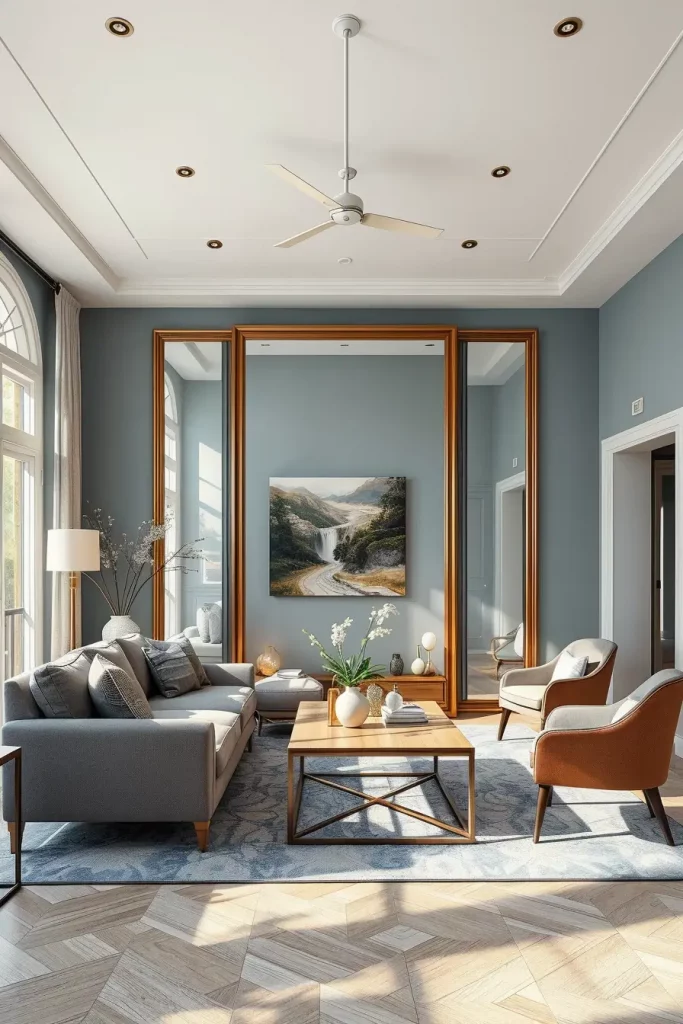
I tend to mix frames with other metallic finishes in the room such as brushed nickel or antique brass to make them look cohesive. A floor to ceiling mirror can also be a statement piece and eliminate the need to have other wall art in some places.

On my part, I adhere to the House Beautiful suggestion to treat mirrors as art- selecting pieces with unusual shapes or frames to accord them as much visual value as paintings. A fireplace with a sunburst mirror or two arched mirrors behind a sofa can immediately add elegance.
My only addition would be mixing the shapes of the mirrors in the same room to give it a curated effect, but frames of the same finish to keep the harmony.
Using Rugs To Ground A Gray Living Room
A room with a lot of gray can be zoned and warmed up by a well-selected rug. I discover that rugs that have a slight pattern or tonal change are interesting but do not disrupt the sophisticated ambiance of the gray living room. They aid in the stabilization of seating and help to make a place comfortable, particularly in open-plan designs.

I would suggest wool or a wool blend as a material since it is durable and soft. A darker sofa is complemented by a light gray or cream rug that provides a soft contrast, with a patterned rug with a hint of muted blue or beige to unify the palette.
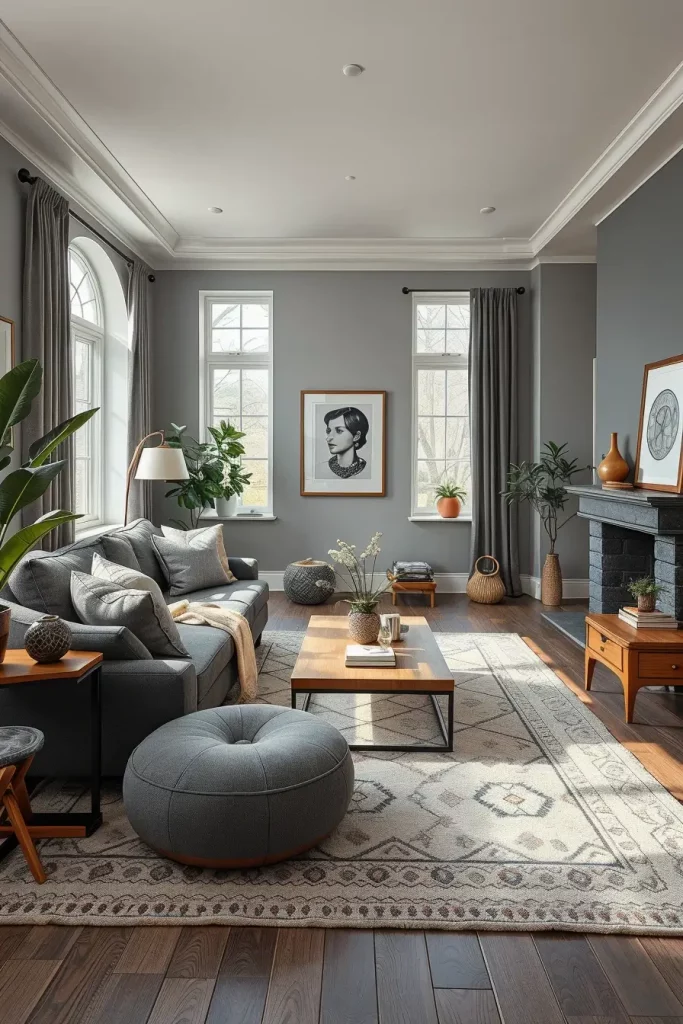
Personally, I have noticed that rugs also enhance acoustics by damping echo in big or empty rooms. According to Better Homes & Gardens, layering rugs is an emerging trend- something I have experimented with where I have a sisal base and a plush accent rug on top to add texture and depth.
I would also say that the front legs of all seating items on the rug makes the room not to feel disjointed, but instead, it makes the room feel as one.
Subtle Patterns That Enrich Gray Designs
Patterns have the ability to take a plain gray living room to a polished one. I like the more subtle ones herringbone, chevron, or tone-on-tone florals as they give dimension without taking away the color scheme.

I prefer to combine patterns using throw pillows, accent chairs or drapery. These items can be interchanged depending on the season and it is simple to change the space without redesigning it.

I think the pattern layering of Martha Stewart would work perfectly here: use large and small scale patterns in the same tonal range to add depth but keep the harmony. I have employed this technique to give rooms a personality that clients were afraid to be too bold.
I would include one more detail and that is patterned wallpaper on one accent wall would add a little bit of interest to the room without detracting the sense of elegance of the gray palette.
Elegant Gray Curtains And Drapery Ideas
The room is framed with curtains that affect the interaction of the light with the gray living room. I tend to go with floor-to-ceiling drapery in textured materials such as linen blends, velvet, or silk. These fabrics hang exquisitely and give an air of luxury.

In terms of color, I either match the curtains to the wall in order to create a seamless effect or I use a shade that is slightly darker or lighter to create a soft contrast. The design can also be enhanced by adding a decorative rod with metallic finish.
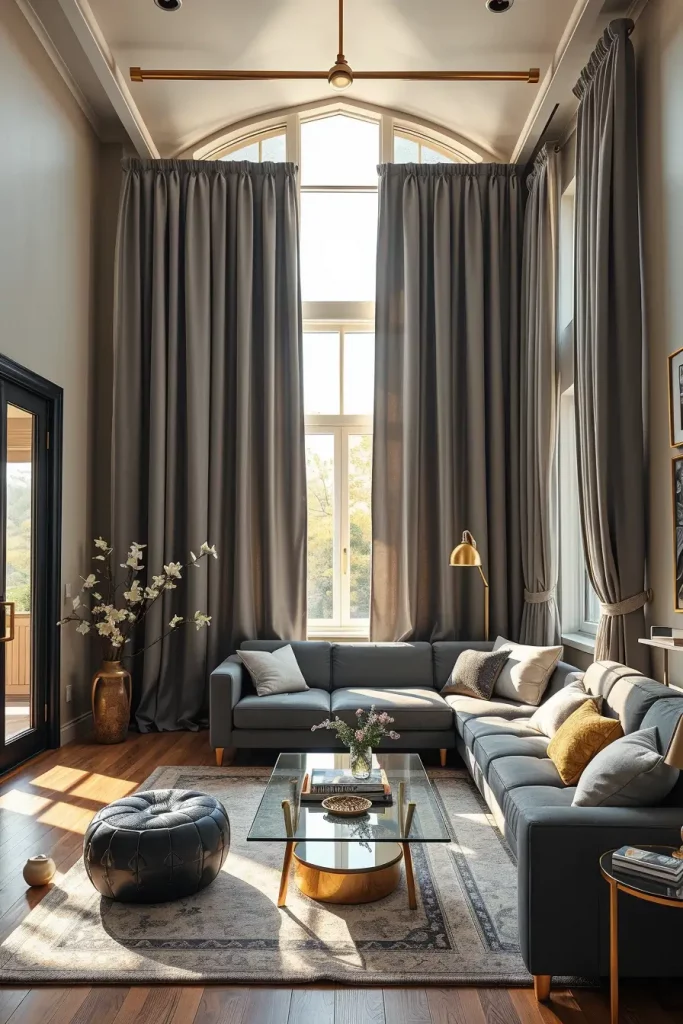
Elle Decor advises on layering sheer and opaque panels by using two curtain rods, which I frequently suggest to allow one to have versatility in controlling the light and privacy.
I would say that the cost of having custom-tailored curtains is well worth it to have the right proportions, and this could be the difference between a finished and a merely okay room.
Incorporating Plants For A Refreshing Contrast
Plants are a marvelous means to add life to a stylish gray living room. Their green colors are in a perfect contrast with the gray palette, bringing freshness without dominating the design.
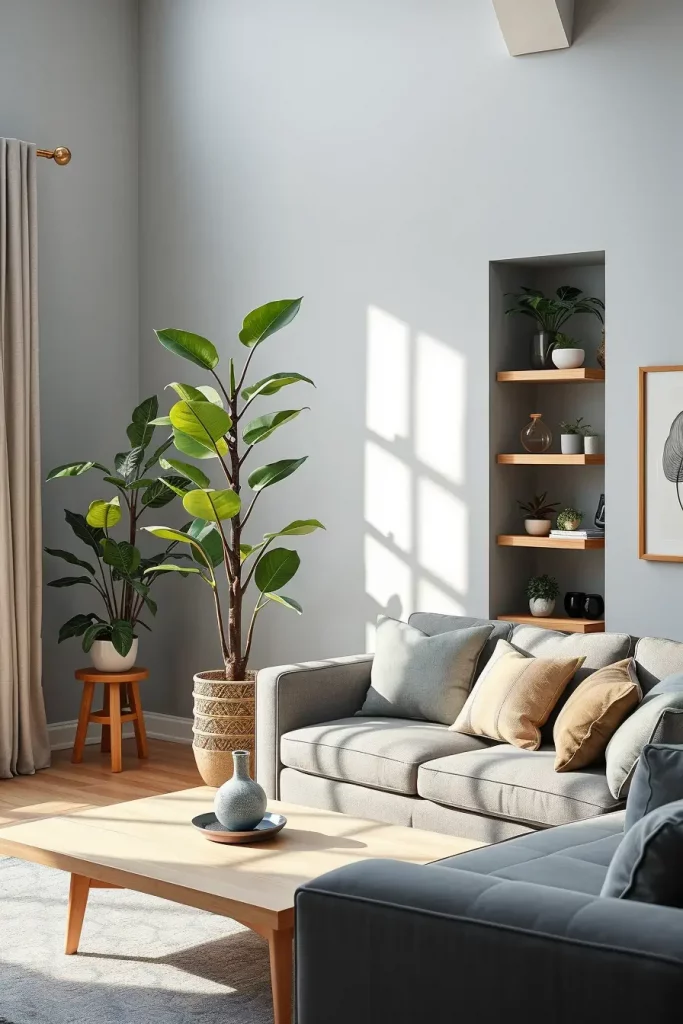
I like tall plants such as fiddle-leaf figs or bird-of-paradise in statement planters to add a big statement, and smaller plants on shelves or side tables to add small amounts of greenery. Pots that are the same color as the metallic or wood in the room helps the room to have a cohesive look.
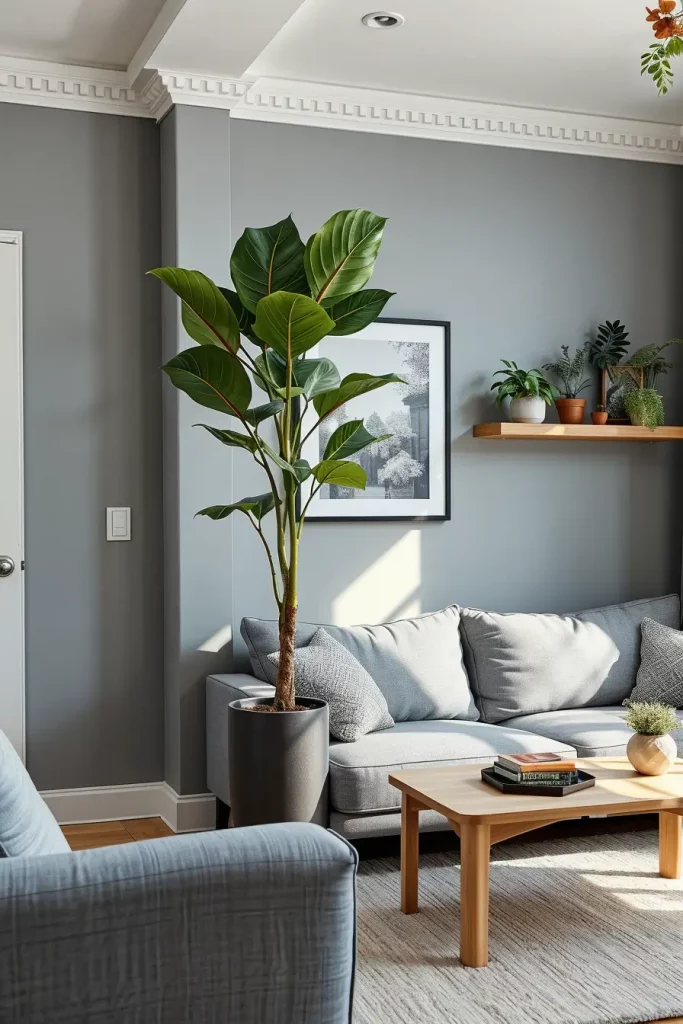
On a personal level, I have witnessed how a few strategically placed plants can make the spaces of clients feel a lot warmer and welcoming. HGTV recommends a mix of heights and texture to produce a natural layered effect which I am inclined to do.
I would also say that I would include low-maintenance plants such as snake plants or ZZ plants so that the greenery would be lively but not so much to maintain.
Accessorizing With Neutral And Bold Accents
Accessories are what make a living room complete when it comes to styling an elegant gray living room. Neutral accents, such as beige cushions, ivory throws, and cream ceramics keep the look sophisticated, but bold accents, such as jewel-toned pillows or a striking piece of art can provide the perfect amount of drama. The secret is to select the accents that do not seem to be chosen by chance, but each of them has a purpose in the design.
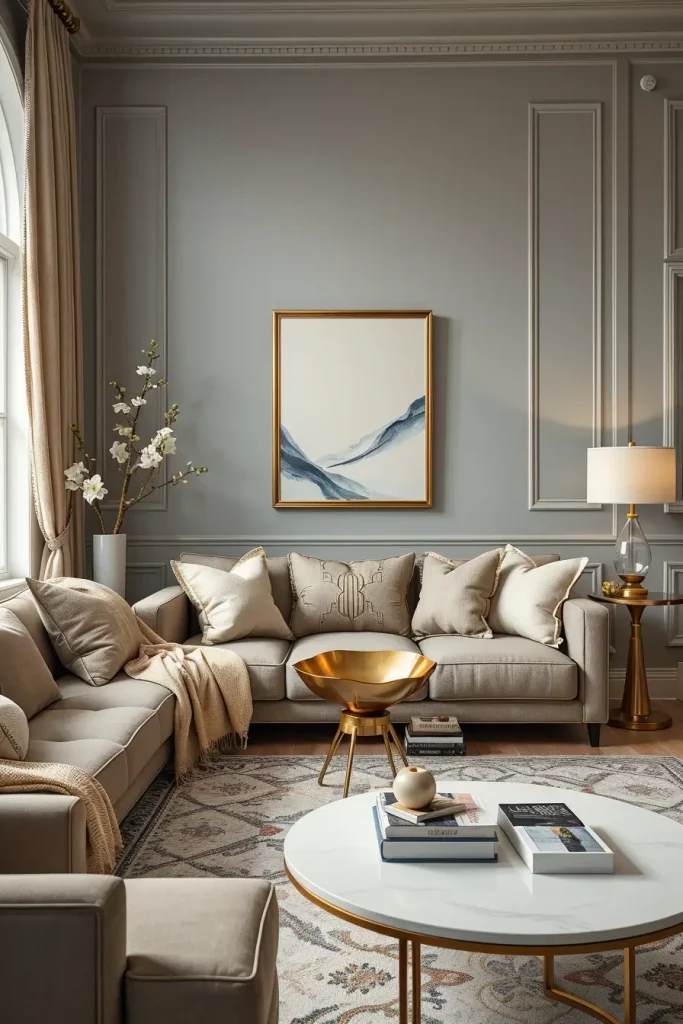
In the case of furniture, I would add a slim side table made of black metal or glass, with a sculptural lamp on top. Layering is done with accessories like coffee table books, small decorative trays and textured baskets, which gives a visual interest and functionality. I usually add one or two bold items, such as a deep blue vase or gold decorative bowl, to interrupt the gray scale.

I think the most helpful tip I have learned at Veranda Magazine is to consider accessories as visual punctuation marks-they lead the eye and establish the rhythm of the room. They also help to make a gray living room feel curated and personal when there is a good balance.
I would also say that you can change the accent colors seasonally to make the room feel new without necessarily redesigning it so that your living room remains stylish and versatile.
Creating Harmony With Balanced Color Schemes
A balanced color scheme is one of my considerations when coming up with a beautiful gray living room. Gray is a flexible foundation, but when combined with complementary colors, such as warm taupes, soft blush, or muted navy, it makes a harmonious setting. An excess of a single tone can make a room look flat and so balance is the important thing.

As an example, I prefer to keep the color of the walls and furniture predominantly gray and add the secondary colors with the help of rugs, cushions, and accent chairs. A pale gray room can be immediately transformed with a soft blush throw on a charcoal sofa or a navy ottoman without being overpowering to the design.

House & Garden frequently suggests the 60-30-10 rule of interiors: 60 percent of the primary color, 30 percent of the secondary color, and 10 percent of the accent. I have used this principle numerous times and it is beautiful with a gray base.
I would also say that the secondary colors can be played with, both warm and cool undertones to adjust the atmosphere, whether it is warm and welcoming or clean and contemporary.
Gray Living Room Ideas For Small Spaces
The small elegant gray living room needs to be designed in such a way that one does not feel cramped in it. I prefer light to medium gray shades on the walls and furniture, which will make the space look more open. As discussed above, mirrors can be a game changer here as they reflect both natural and artificial light.

When it comes to furniture, I am more of a multi-purpose furniture person, such as a storage ottoman or a sofa that has a pull-out bed. The use of compact coffee tables that have glass tops also makes them appear open, yet they have a surface on which decor and daily activities can be placed.
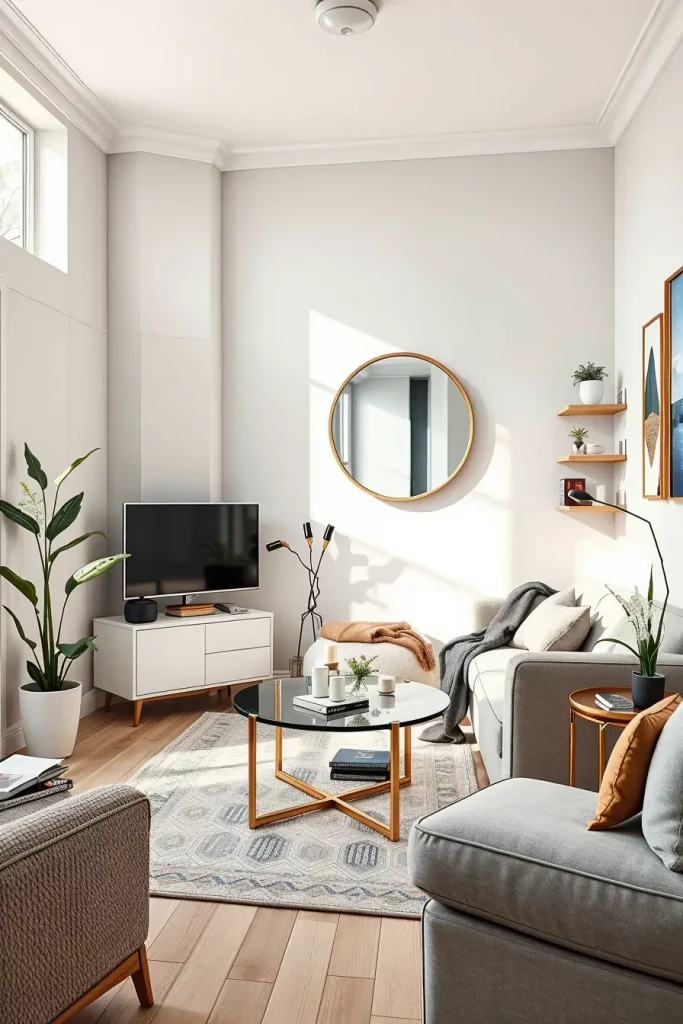
Personally, I have found that Apartment Therapy tends to focus on the use of vertical space in small rooms: tall bookshelves, floor lamps, high-hanging drapes make the ceiling seem higher. I have witnessed these tricks to transform the size of a room.
I would say that in small rooms, less and bigger decorative items tend to be more elegant than many small items, which are cluttered.
Open-Plan Living Rooms With Gray Coordination
The gray color can be used as the unifying color in an open-plan home to achieve a smooth transition between spaces. I usually suggest that the color of the wall should be the same in the adjoining rooms, and the areas should be separated by the use of rugs, furniture, and lighting. This strategy makes the entire space cohesive and yet establishes functional areas.
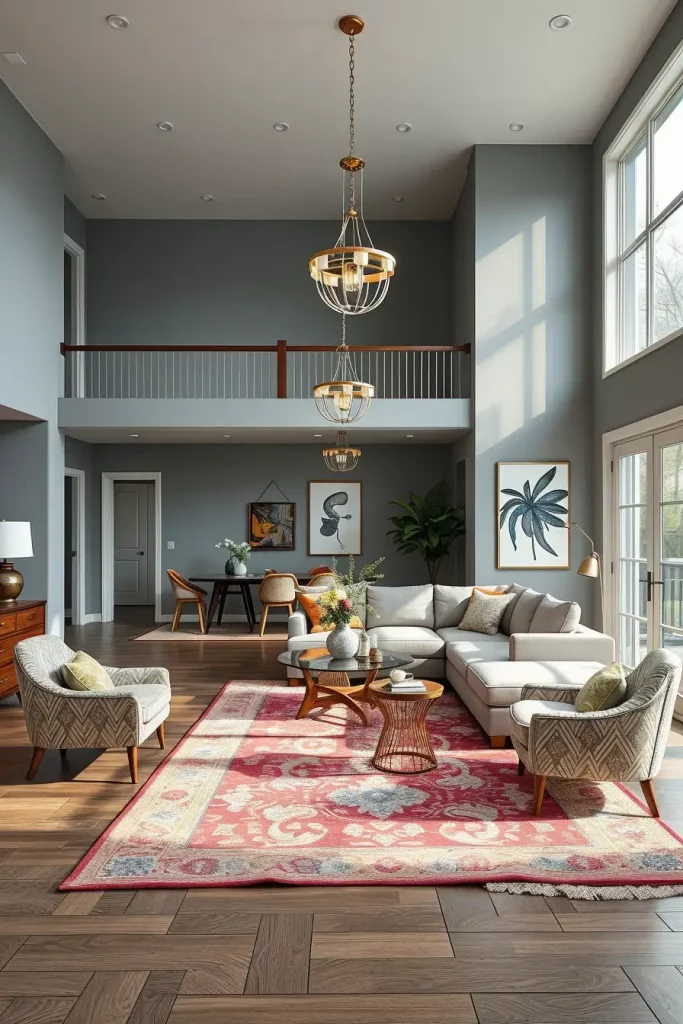
In the case of furniture, I prefer sectional sofas that separate living rooms and dining rooms without obstruction of views. Accent chairs that are coordinated in a shade lighter or darker gray make the palette interesting, and pendant lights above the dining table assist in grounding that space.
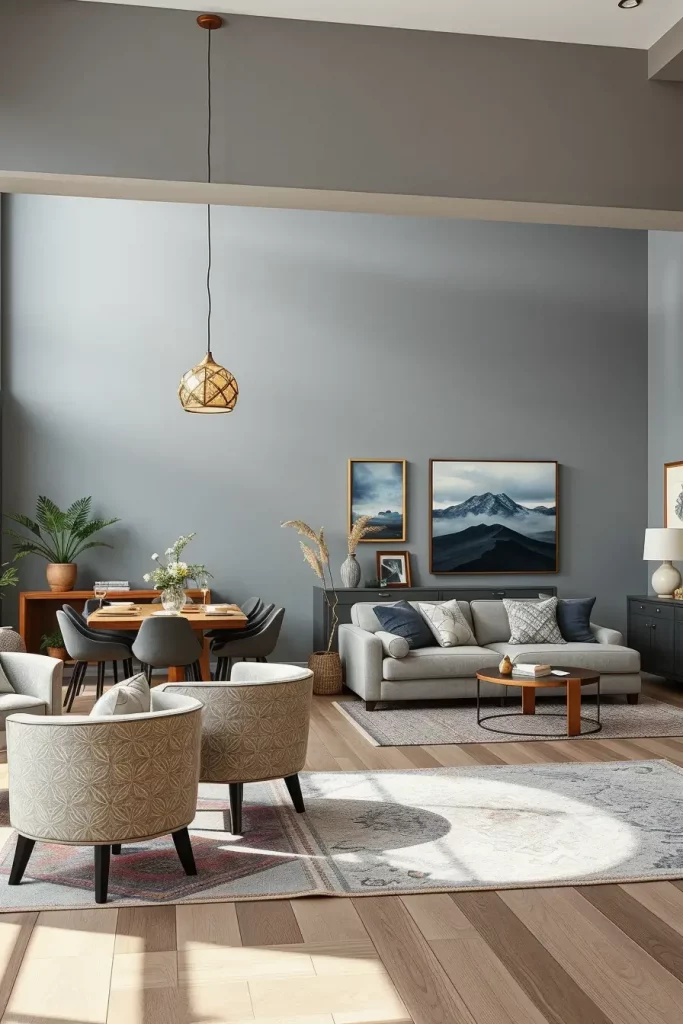
Elle Decor recommends that color continuity is what binds open-plan spaces together. I have used this by selecting matching or complementary finishes of wood, metal and fabrics in all zones.
I would also say that artwork can be used as a strategic element between two areas to ensure a smooth shift in the eye between two areas whilst still ensuring each area has its own specific purpose.
Minimalist Gray Interiors For Sleek Sophistication
Clean lines, uncluttered surfaces and a well-chosen collection of furniture and decor are the key to a minimalist elegant gray living room. I tend to like low profile sofas, hidden storage and sparse lighting to get a clean, minimalistic look.

In minimalist rooms, nothing should be there without its right. I prefer to select one outstanding piece, e.g. a classic chair or a spectacular light, as the centerpiece. The plain wool, cotton or linen textiles can be used to tone down the minimal aesthetic without sacrificing its sharpness.
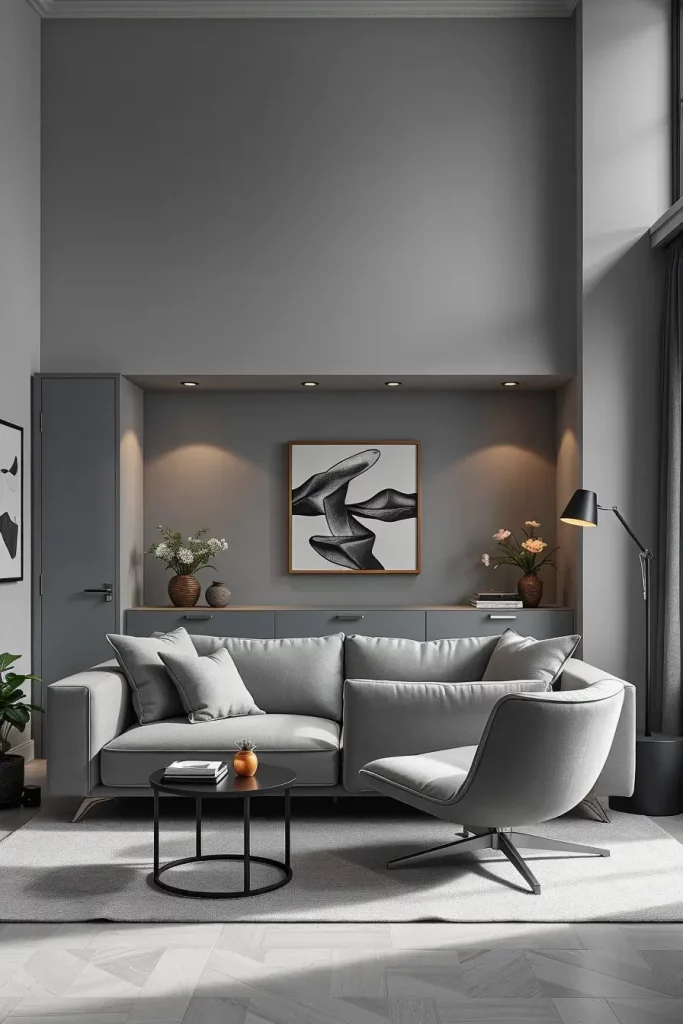
Architectural Digest frequently points out that minimalism is all about restraint and I would have to agree, it is just as important to leave negative space as it is to add the pieces. I have discovered that a gray color scheme helps in this technique, because it makes textures and shapes more visible.
I would also include the fact that the cable management is hidden and there is built-in storage which is a key to achieve the minimalist look in a living area.
Cozy Gray Corners For Relaxation
My favorite design problem is to make a comfortable corner in a lovely gray living room. An armchair, a soft throw, and a side table can transform a corner that is not used into a personal retreat in a moment. It is completed by adding a floor lamp with warm lights that make it ideal to read or relax.

In the case of furniture, I would like plush chairs with curved backs and ottomans to make it more comfortable. The space is further welcoming with a textured rug on the floor and cushions of muted colors layered on top of each other.
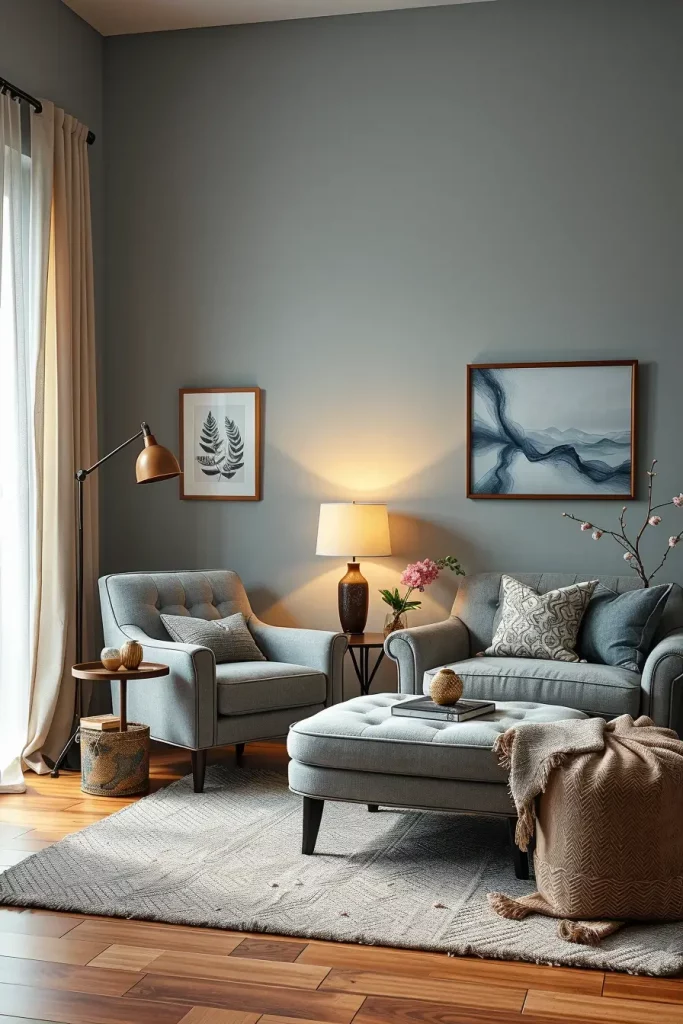
Better Homes & Gardens frequently recommends tactile fabrics to warm up a room- velvet, chenille, and faux fur all work well in a gray corner arrangement. Personally, I have witnessed clients being drawn to these spaces when they are softened.
I would say that a small bookshelf or a wall mounted shelf in the vicinity of the sitting area would make the nook even more practical and individual.
Seasonal Updates For A Gray Living Room
A beautiful gray living room is an ideal background to seasonal changes. I adore the fact that you can easily change the accent colors using cushions, throws and small decorative pieces without having to change the overall furniture or the wall color. In winter, I could wear deep jewel tones and in summer, I use lighter hues such as pale blue or soft blush.

Regarding the decor, the room can be changed by using seasonal flowers, candles, and art to change the mood subtly. To change the rug or drapes to a different season can make the whole look new.

Real Simple magazine tends to note that neutral base is cheaper in the long run since you just have to change small accessories to have a completely different impression. I totally concur and I have applied this method in various client homes with great success.
I would also say that having a seasonal decoration box in the storage can help to make the process of exchanging items in the change of season quick and stress-free.
Incorporating Art Pieces Into Gray Interiors
In creating a classy gray living room, I never fail to put into consideration how art will play with the dull colors. Gray is the best background of art and colors and textures can be noticed without dominating the room. I tend to suggest bigger statement pieces or gallery walls that are well curated to make a focal point. This is not just a way of adding personality, but also of attracting attention, which adds depth and sophistication to the space.

When it comes to furniture, I am more likely to choose low and thin sofas in dark charcoal or light dove grey, accent chairs in light complementary colours. Artwork frames can be matte black or brushed gold, depending on whether I am in the mood to have a modern touch or a warmer and more classic feel. Glass or marble top side tables are used to reflect light and prevent the room to be too heavy.
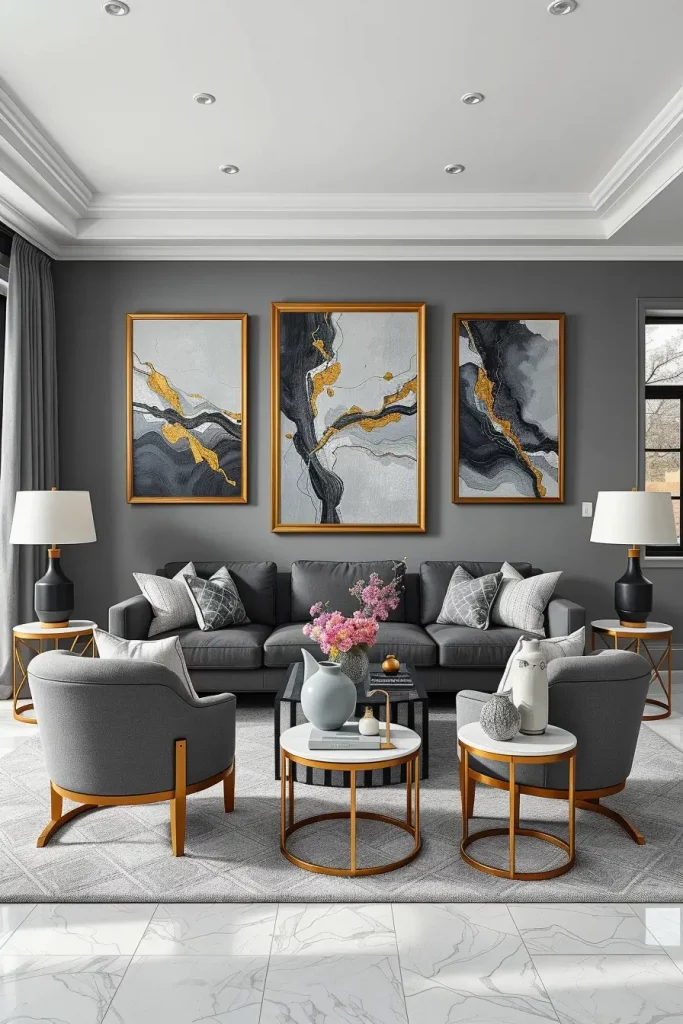
Personally, I have found that designers such as Nate Berkus would stress the value of art placement- that art should be hung at eye level and be balanced with the furniture below it. I adhere to that rule pretty strictly, because it makes the art feel part of the whole design and not an afterthought.
To add even more to the appearance, I would recommend placing one sculptural object, i.e., a ceramic vase or abstract metal object, on a console table. This makes the room lively without being distractive to the main artwork.
Maintaining Elegance With Smart Storage
A beautiful gray living room can soon become ugly when clutter takes over. The room has to be kept in a refined aesthetic, and smart storage solutions are necessary. I like built-in shelves painted in the same or a little darker gray that will merge with the walls and will give a chance to the decorative elements to stand out. This is also to prevent disruption of the clean flow of the visual.
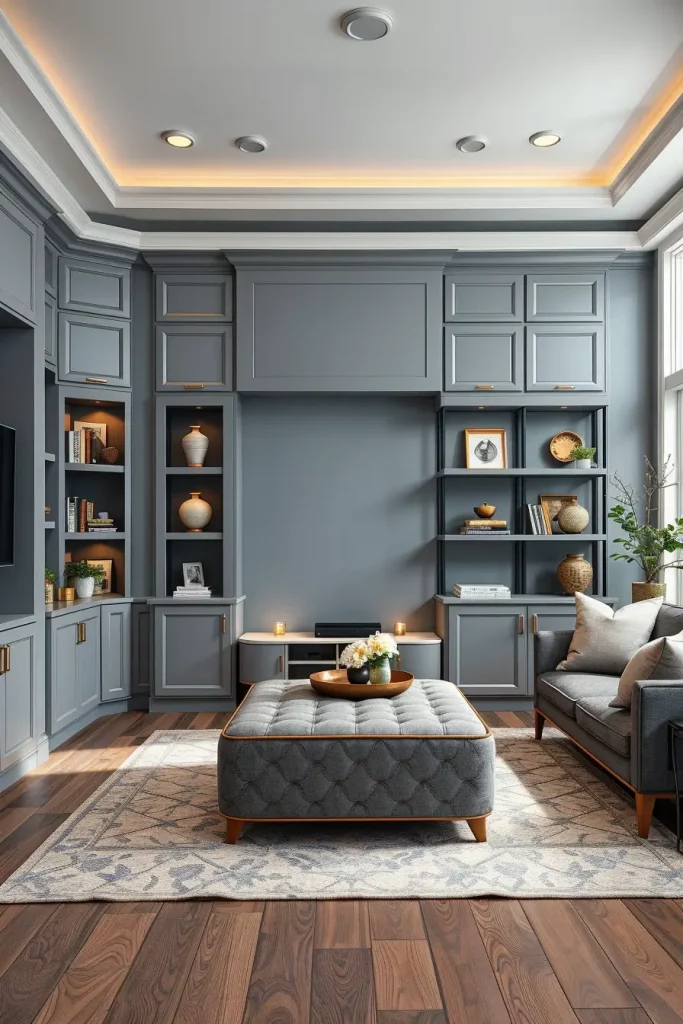
Storage ottomans, low-profile cabinets with a sleek design, and modular shelving systems that can conceal daily objects without losing their style are some of the furniture options here. Soft-close drawers and hidden compartments ensure that things are practical yet still have that polished feel.
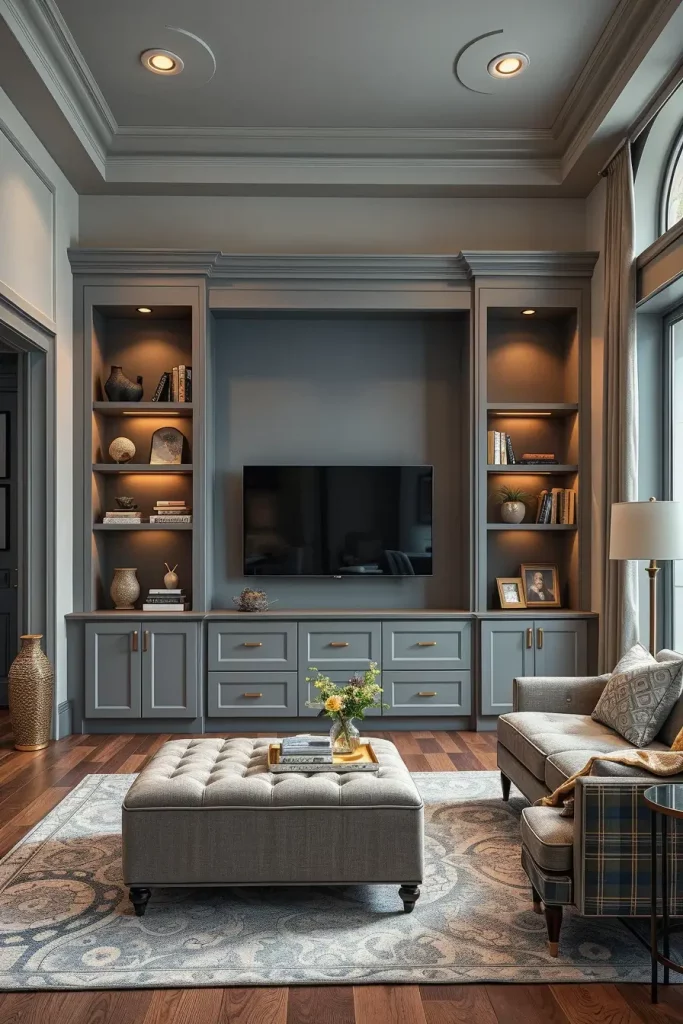
In my own work, I have discovered that it is the inclusion of open shelving with a few carefully selected decorative objects such as coffee table books, candles, or framed photographs that provide balance. According to interior expert Emily Henderson, open storage should not be too much as it creates visual clutter, hence having it partially closed will keep it elegant.
To improve functionality, I would suggest having charging points in storage units to have a clutter-free appearance. This hides cords and devices and does not compromise the sophistication of the room.
Lighting Tips For Enhancing Gray Tones
Lighting is very important in ensuring that a sophisticated gray living room does not appear cold. I tend to overlay various styles of lighting such as ambient, task and accent to add depth and interest. The mood is set by a large central chandelier with a dimmer switch, and table lamps and wall sconces create intimate areas of light.

I usually prefer warm LED bulbs to neutralize the cool undertones of gray. Lighting fixtures can also add color to the palette, with metallic finishes such as brushed nickel or antique brass. Adjustable-arm floor lamps are excellent at pointing light at reading corners or at art objects.
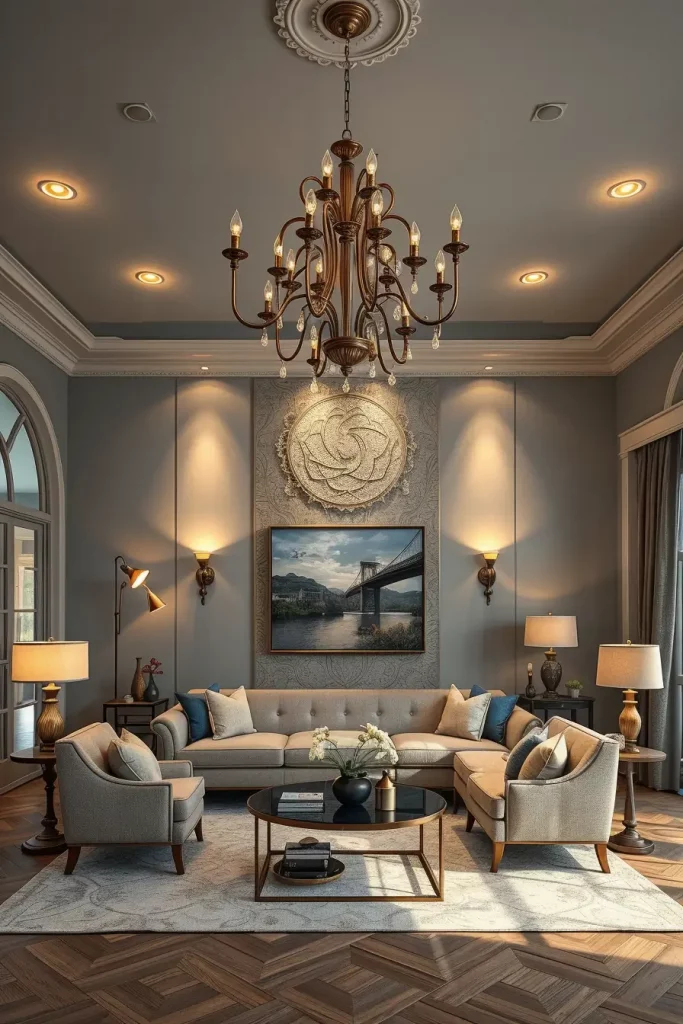
Architectural Digest has given me tips on the placement of lights where they usually advise to place lights to highlight texture. As an illustration, light can be pointed at a textured accent wall to enhance the gray hues and make them look more vibrant.
Another thing I would do to make this better is to include recessed lighting in some important places like above seating areas. This provides a balanced light without dominating the atmosphere of the room.
Final Touches For The Perfect Elegant Gray Living Room
After the key components are established, it is the finishing touches that complete an elegant gray living room. I concentrate on layering textures plush rugs, soft throw blankets and velvet cushions to give it warmth and dimension. The dainty metals on decorative bowls, lamp bases or even mirror frames offer a sophisticated sheen but not too much.
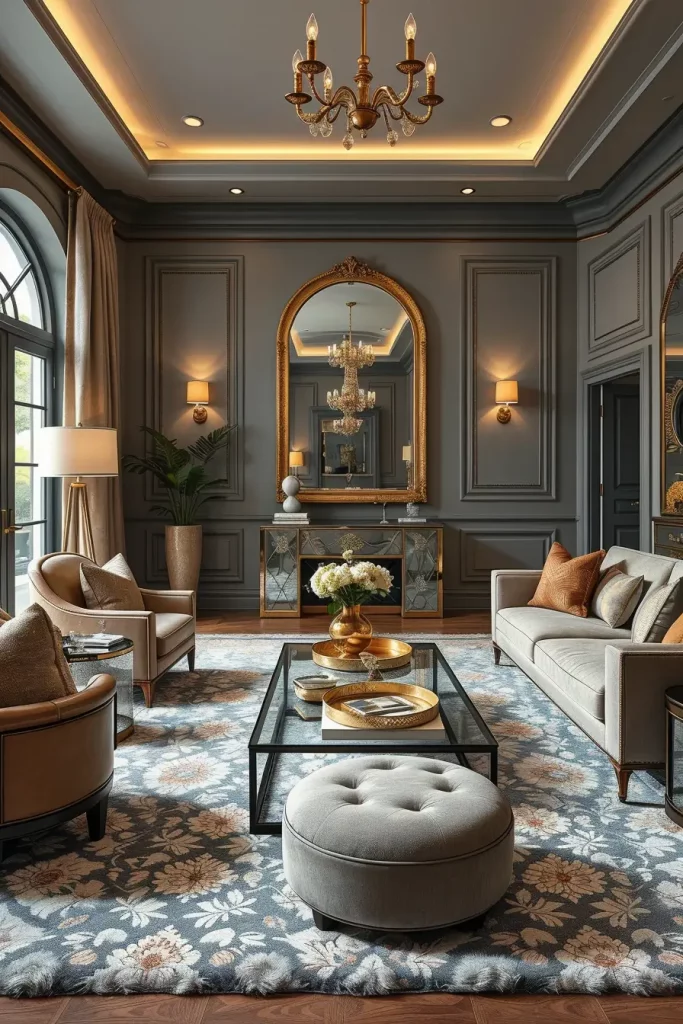
The furniture in this case should be of a similar style but different in texture. As an example, a soft linen sofa and a smooth leather armchair are visually interesting. Tables with glass tops assist in maintaining the room light and airy and mirrored trays on the top can reflect light in the most beautiful way.
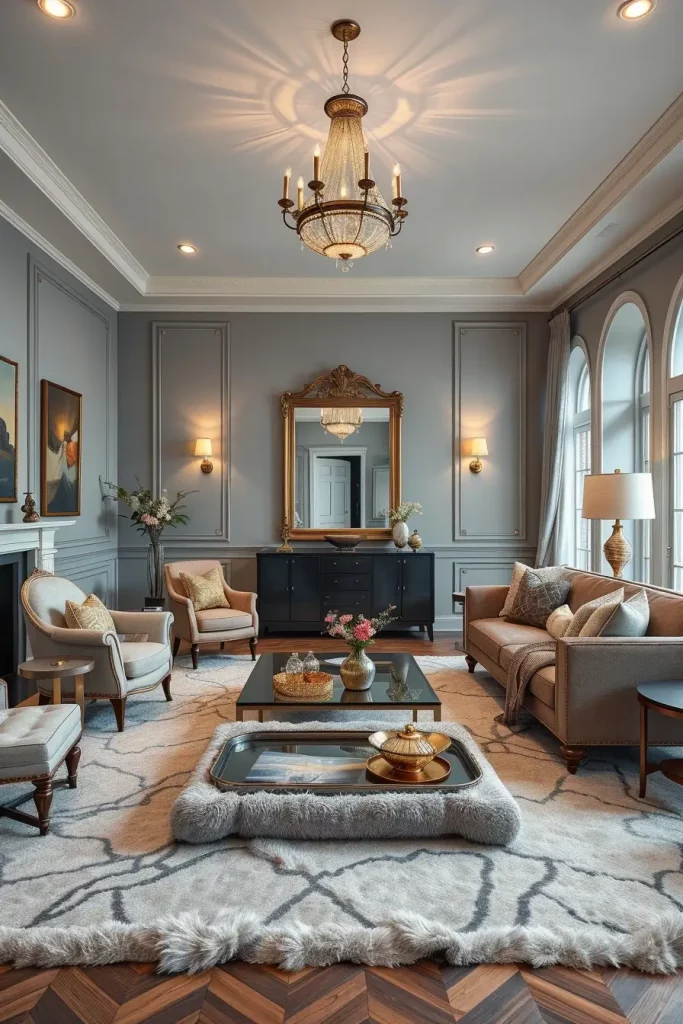
In my opinion, one outstanding accessory, such as an oversized floor mirror or a designer statement chair, can become the key element of the room. Elle Decor notes that a single or two pieces of high quality instantly transform the appeal of the whole room.
In case I would be polishing the space even more, I would make sure that all accessories serve a purpose. This does not mean using random knick-knacks but rather choosing things that add to the general story of the room and its beauty.
A tasteful gray living room is all about balance, about a mix of style, comfort, and functionality to make a room that is timeless and cozy at the same time. Through careful selection of art, clever storage, layered lighting and finishing touches you can turn gray as a basic neutral into the basis of a sophisticated interior. Which of these concepts would you experiment with in your own house? Share your thoughts in the comments!
